

Top 10 Sound Experiments: Fun & Easy
Sound, an intrinsic part of our lives, is more than just a medium for communication and entertainment. It is a fascinating scientific concept, offering insights into how energy travels and interacts with our environment.
This carefully curated selection is designed for learners of all ages, covering fascinating topics like vibration, sound waves, pitch, and resonance. These hands-on, educational experiments will not only amplify your understanding of the science of sound but also strike a chord with your innate curiosity.
We hope you enjoy this compilation of sound experiments and that it inspires you to continue exploring the wonders of science.
1. How to See Sound Experiment
The How to See Sound experiment is a fascinating way to explore the relationship between sound waves and visual patterns.
The How to See Sound experiment is a fun and insightful experience that is likely to pique your interest, whether you’re a scientific enthusiast, an artist, or just someone who enjoys discovering the wonders of the world around you.
2. Glass Bottle Xylophone
Seeking an innovative and entertaining technique to learn more about the science of sound? With the help of the Glass Bottle Xylophone experiment, students can build their own musical instrument and learn about the fundamentals of sound.
3. Singing Spoons
Do you want to learn more about the science of sound in a playful and imaginative way? Using just a few spoons, the Singing Spoons experiment is a fascinating and fun project that you should try.
4. Make a Straw Oboe
Make your own musical instrument by cutting a straw to a specific length and blowing across the top to create different notes. Experiment with different straw lengths to produce different pitches.
5. Create a Thunder Drum!
Creating a thunder drum is a unique and exciting way to explore the properties of sound and can help students understand these concepts in a more tangible way.
6. Musical Wine Glasses
The musical wine glass experiment is a fun and easy way to explore the science of sound and create your own musical instrument. By filling wine glasses with different amounts of water and tapping them with a spoon, you can produce a range of musical notes and create your own melodies.
7. Tuning Fork Resonance Experiment
The tuning fork experiment is an established representation of how resonance and frequency work in the study of sound.
Students can see and measure the effects of resonance and frequency in this experiment by experimenting with various objects and tuning forks of different frequencies.
A hands-on introduction to the fundamental concepts of sound and waves is provided by this simple yet interesting experiment.
8. The Doppler Effect with Sound
Through the use of sound waves generated by a moving sound source, students can investigate the Doppler effect in this experiment.
Students can learn about the Doppler effect and its use in disciplines like astronomy and radar technology through this exercise in an useful and fascinating way.
9. Soundproofing Experiment
Students can learn about the science of soundproofing and its importance in building pleasant and effective surroundings through this project, which is a practical and hands-on learning experience.
10. Standing Waves
With the help of this experiment, students can learn about the fundamentals of wave interference and resonance as well as how these ideas are used in real-world situations.
Similar Posts:
- 68 Best Chemistry Experiments: Learn About Chemical Reactions
- Top 100 Fine Motor Skills Activities for Toddlers and Preschoolers
- Top 58 Creative Art Activities for Kids and Preschoolers
Leave a Comment Cancel reply
Save my name and email in this browser for the next time I comment.
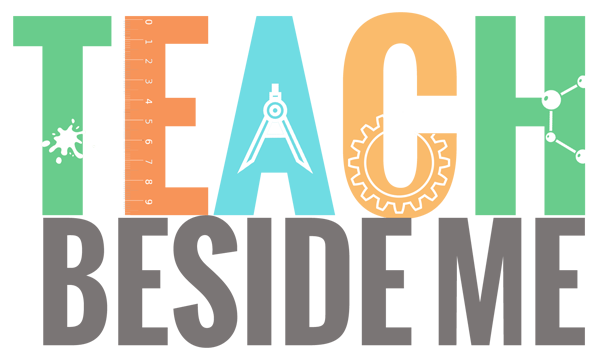
5 Sound Wave Experiments for Kids
This post may contain affiliate links.
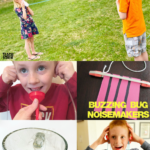
Teaching little ones about the 5 senses can be so much fun! Today I want to show you some fun and easy sound wave experiments you can do with your kids!

Sound Wave Experiments for Kids:
Following are five fun sound wave experiments you can make at home with just a few simple supplies. Your kids or students will love them. If you are teaching about the human body and how ears work, or maybe have a lesson on the five senses, I am sure you will find one of these that will work perfectly for you!
Experiment #1 The Magic Ear Trick
The first sound wave experiment is this magic ear trick. This sound trick makes you think the sound is coming from the opposite direction from where it really is coming from. It tricks your brain! We saw this at a science museum a few years back and my kids had so much fun with it that we wanted to try to recreate it at home.
To make it, you need small tubing (I got this fish tank tubing ), two small plastic funnels and a piece of PVC pipe or paper towel tube.
Attach a funnel to the end of each piece of tubing. We secured ours with duct tape .
Put the tubing through the pipe with each one going in the opposite direction.
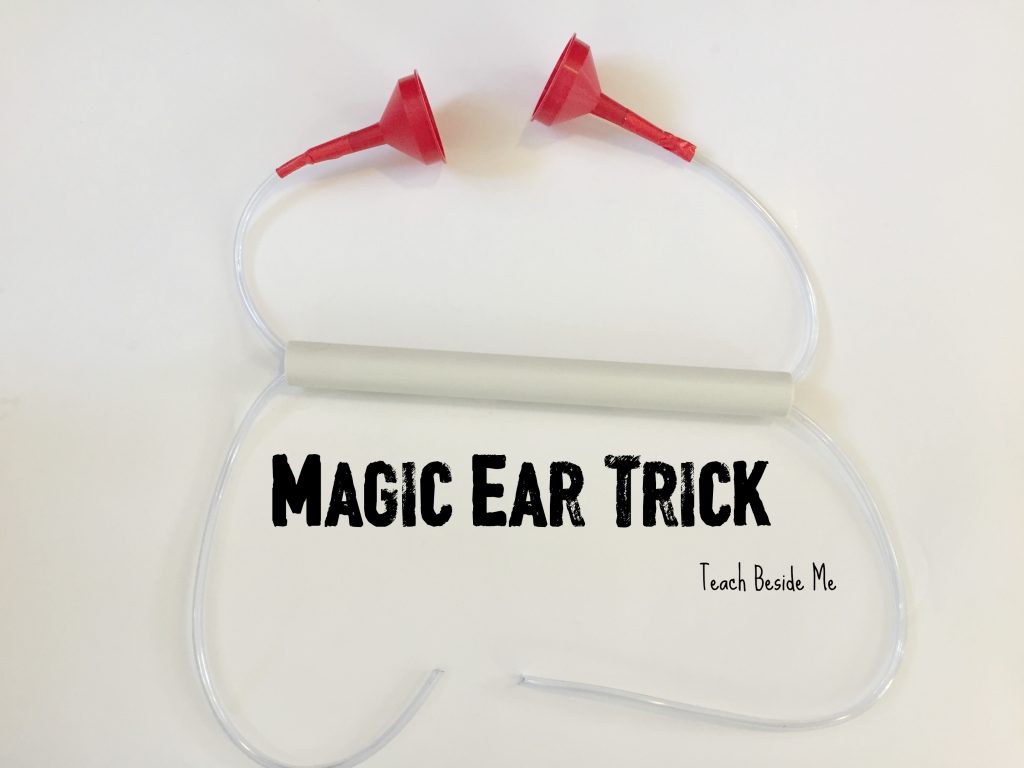
Place the end pieces in each ear.
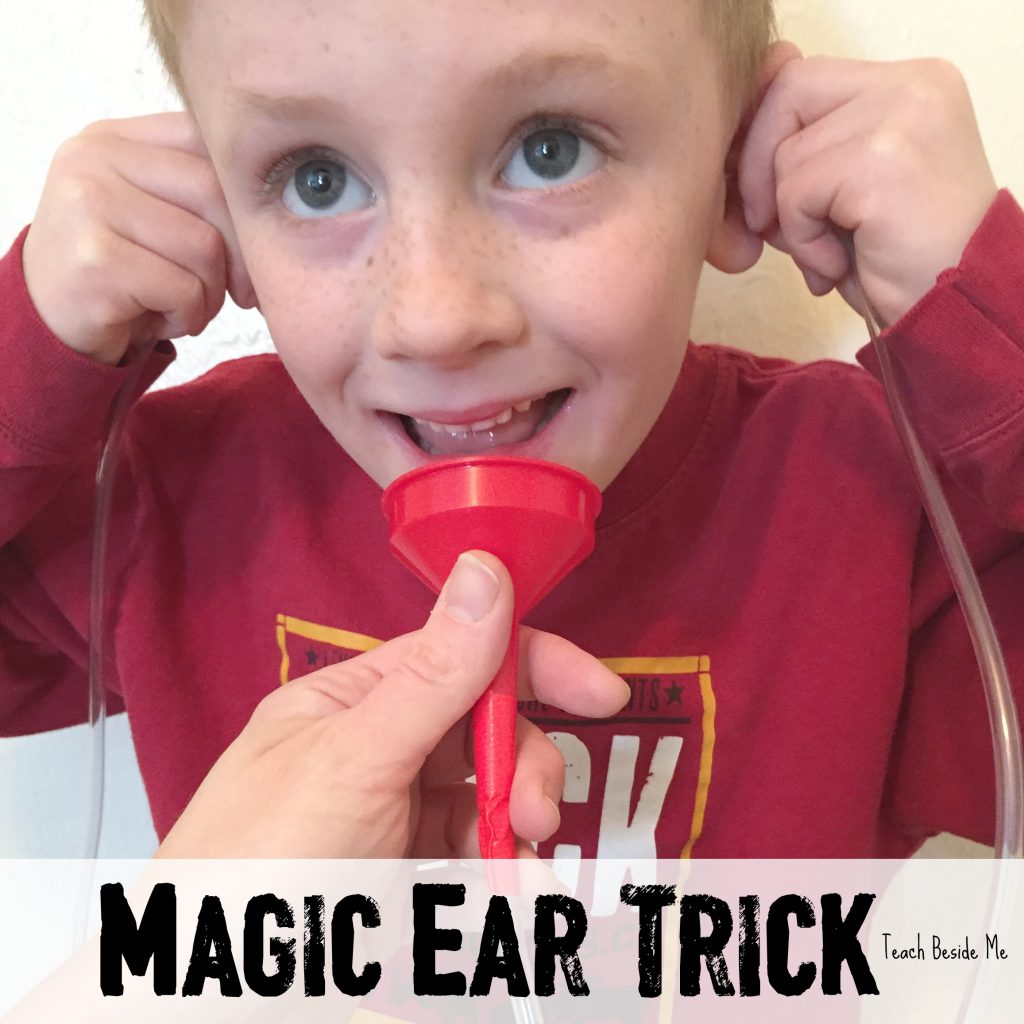
Have someone talk into the different funnels. You could move it up behind their head so they don’t know which one you are talking into. Then let them guess which side you are talking on. It will be the opposite ear from where you are making it like a magic trick!
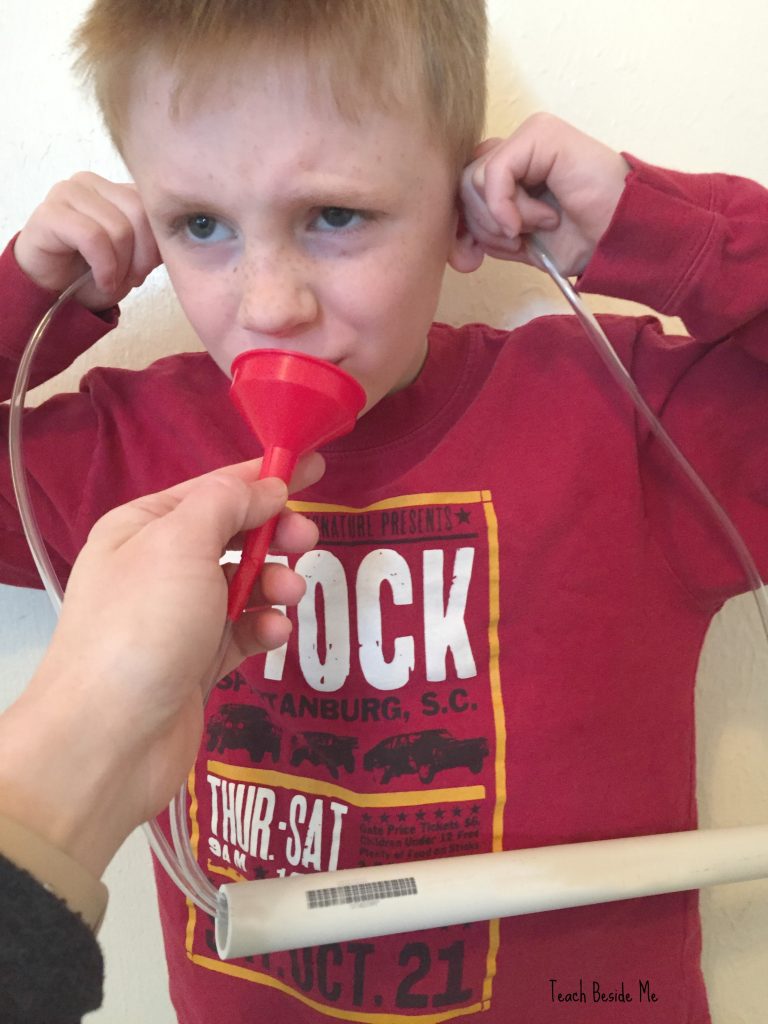
It’s really funny to watch kids faces when they hear it. I love his confused look in that picture above! It got my son laughing so hard that he could not tell where the noise was coming from!
What’s Happening?
The sound is traveling through the tubes, Your brain thinks the one on the right will be heard in the right ear, but it is the opposite! It tricks your mind and confuses you!
Sound Wave Experiment #2 The Ringing Fork on a String
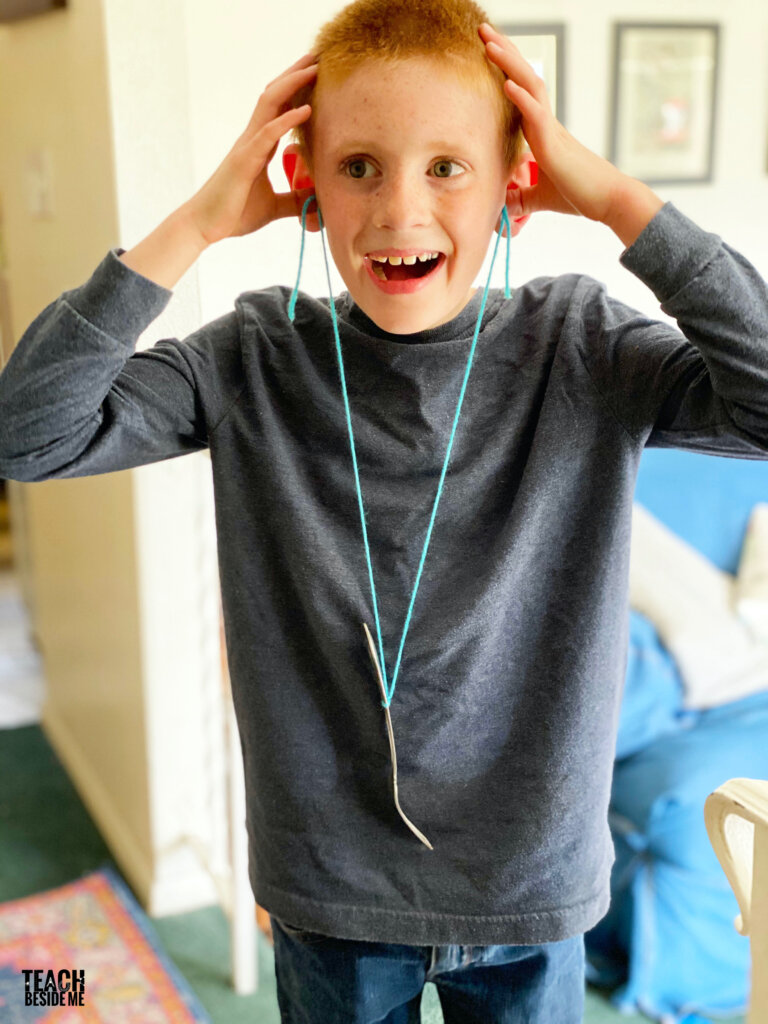
For this simple sound wave experiment you just need a fork or a spoon tied onto a piece of yarn. Make sure the yarn is long enough to hang down from your ears to around your chest or stomach. Tie the fork right in the center of the piece of yarn or string.
Now, tuck the ends of the yarn into your ears and tap the fork on an object. You will hear a large gonging sound or a ringing in your ears! The funny thing about this is that nobody else hears it like you do. And everyone is shocked at how loud the sound is!
The Science Behind It:
When the fork hits another surface it will vibrate. These vibrations make the air around it move, too. These are sound waves! The vibrations, or sound waves, move up the string and allow your ears to hear it. Sound travels best through a solid object, no the air.
Sound Wave Experiment #3 Make a Cup and String Phone
This is a great classic experiment that’s been around as long as I can remember. But it is still so much fun to do with young kids! You need two plastic or paper cups and a long piece of string or yarn.

Poke a small hole in the bottom of each cup. Put the string through the holes and tie knots on the inside to keep the string in place. Do this with both cups.
Now pull the string tight- it needs to be tight for the phone to work and the sound waves to be able to travel through the string. On person puts the phone to his or her ear and the other to their mouth. Whisper or talk quietly into the cup and the other person will hear the sound of your voice in the cup!
My kids like to make two to use at once, then they can both talk and listen without switching the cups back and forth.
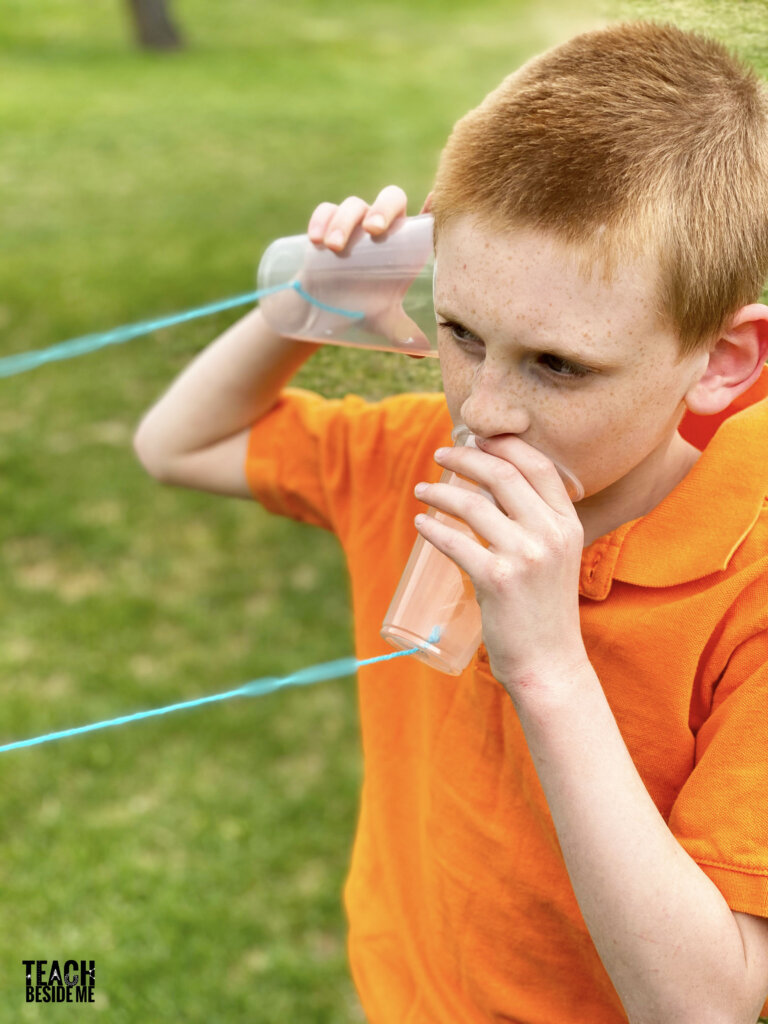
When we talk, our vocal cords vibrate beginning the motion of the sound waves. Our ears have tiny hairs inside that pick up those sound wave vibrations and send them to our brain to translate. When you talk through the phone, the string carries those waves from one cup to the other allowing us to hear each other!
Experiment #4 Make a Buzzing Bug Noisemaker
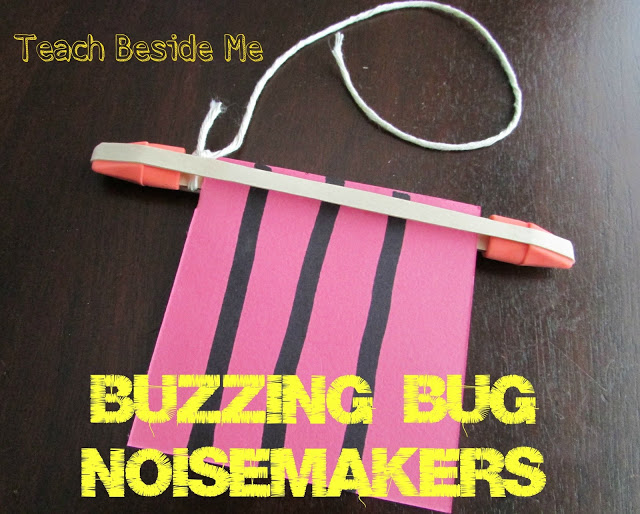
This is a fun experiment! You can find all of the instructions to make it here: Sound Experiment: Buzzing Bug Noisemaker Toy
This buzzing bug noisemaker simulates the sound of insect wings that bus when they fly. It’s simple to make and kids love playing with them! You just spin them around and listen to them buzz.
Sound Wave Experiment #5 Seeing Sound Waves~ Dancing Sugar
This is an easy experiment to put together and a great visual for seeing how sound waves work!
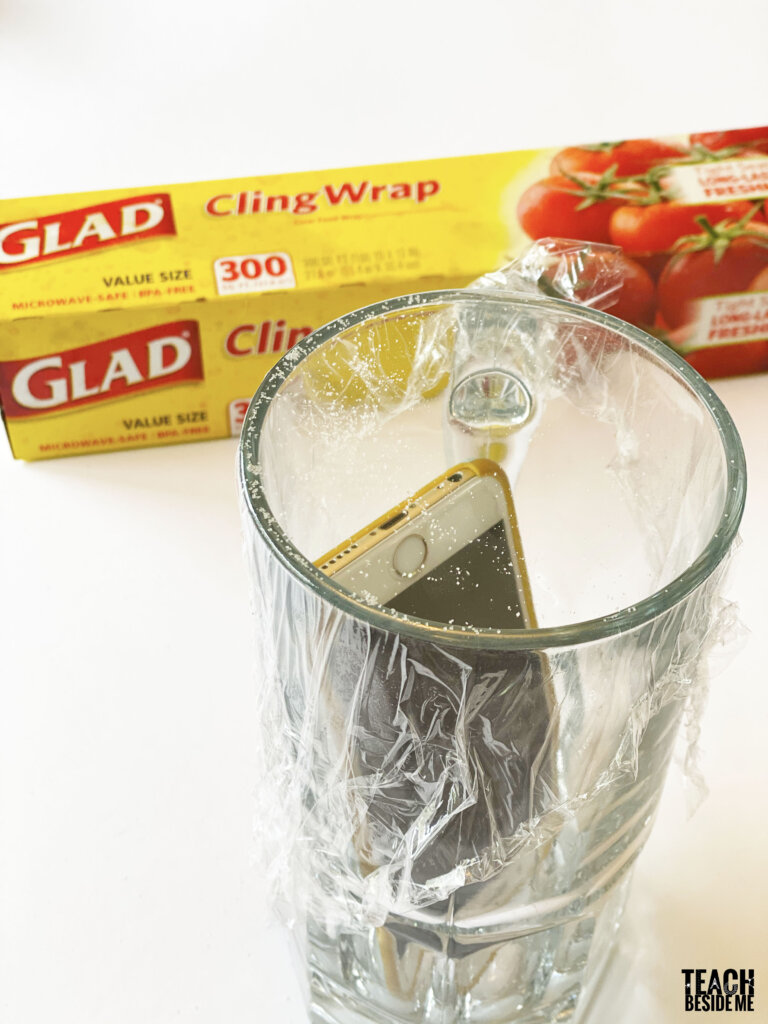
Put a phone in a glass. Turn on some loud music with a lot of great bass. Cover the glass with plastic wrap and sprinkle some grains of sugar on top of the plastic wrap. You will be able to see the sugar dance! It is really cool.
Now explain to the kids how this works! The vibrations from the sound waves are making the sugar move.
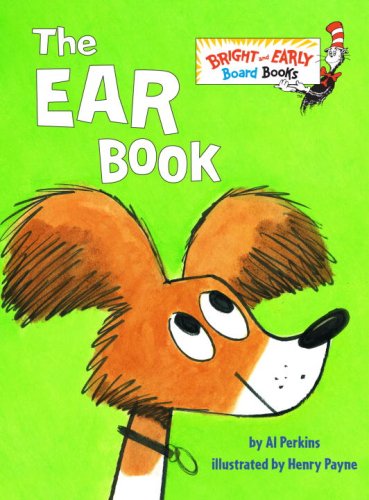
Expand this lesson on ears and sound by reading The Ear Book by Al Perkins with your kids. It’s such a fun one!
Want more sensory activities for the 5 senses? Check these ones out:
- Try this Guess the Spice Activity for the sense of smell.
- Try this Tapioca Pearl Sensory Play activity for the sense of touch.
- Try a Cake Chemistry Experiment for the sense of taste.
- Try Color Mixing with Light for the sense of sight.
- Five Senses Activities for Kids
Former school teacher turned homeschool mom of 4 kids. Loves creating awesome hands-on creative learning ideas to make learning engaging and memorable for all kids!
Similar Posts
Bead drums- homemade musical instrument, dash & dot ~ teach kids programming.

Kids Gardening Math: Growth & Measurement

Lemon Battery Experiment
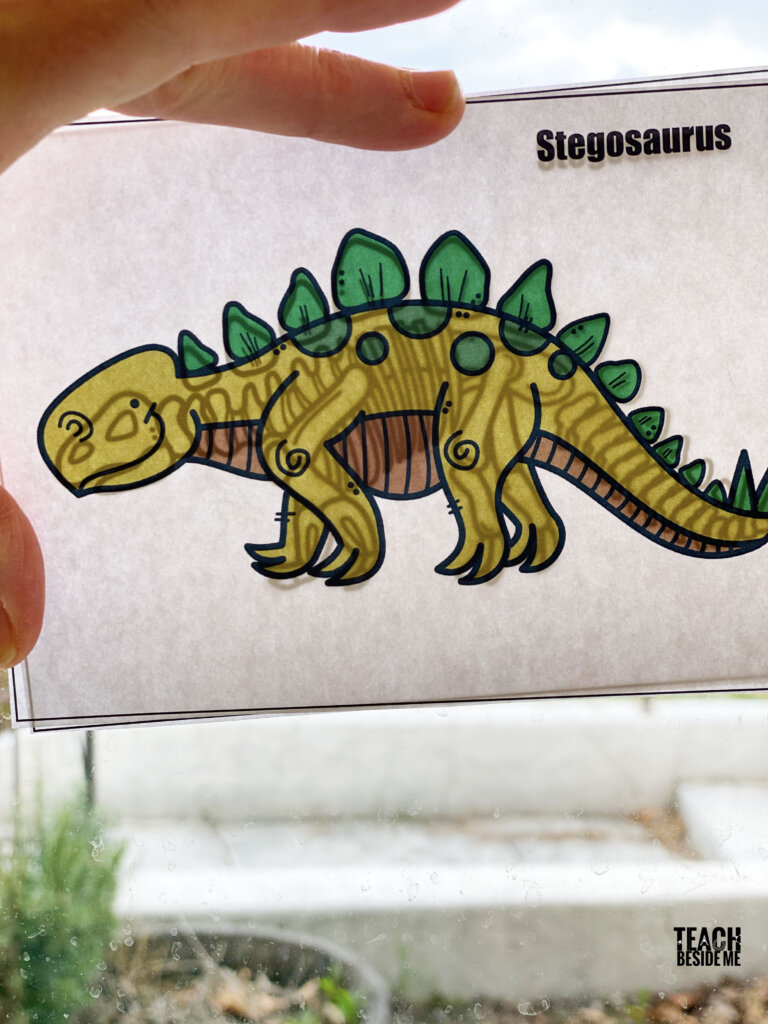
Build a Dinosaur Puzzles & Matching Game

Homemade Bird Feeders (Without Peanut Butter)
Leave a reply cancel reply.
You must be logged in to post a comment.

Educational Activities, Toys, and all things STEM
Science Experiments with Sound: 8 Fun Activities for Kids
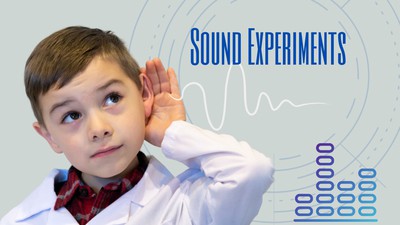
*We’re an affiliate – we may earn a commission through qualifying purchases from the links on this page. As always, thanks!*
Sound is all around us, traveling in invisible waves. Since we can’t see it, we often take sound for granted. Today we’re doing some science experiments with sound. We’ll have some fun learning how sounds waves vibrate, how we can affect the vibrations, and how this affects what we hear. Listen up & let’s explore!
Jump to your favorite science experiment with sound: Sound Vibrations on a Flat Surface Drinking Glass Bells Cup and String Phone Big Box Bass Sound Tubes Stretched Strings Pipe Organ with Cardboard Tubes Soundproofing
Sound Vibrations on a Flat Surface
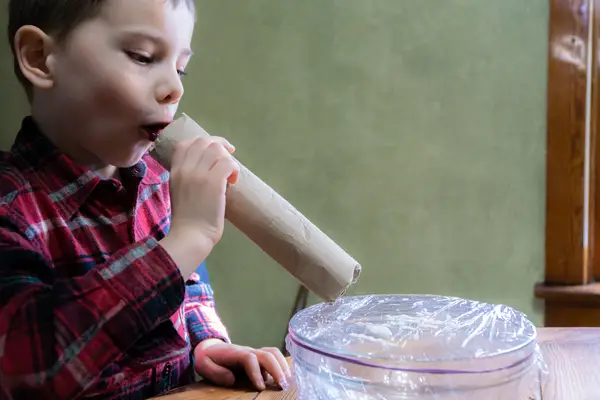
Here’s an easy science activity with sound we can do using items you most likely have in your kitchen. We’re going to see how sound waves cause vibrations and the affect this has on objects. You’ll need a few household items:
- Plastic wrap
- A rubber band
- Salt, Sugar, or dry rice
- Stretch some plastic wrap over a bowl. Pull it tight.
- Secure the plastic with rubber bands
- Sprinkle some salt on the plastic (or sugar or rice)
- Make some noise!
What’s Happening?
Even though you cannot see the sound waves, you can see their effect. The salt should bounce along the top of the plastic in response to sound. The louder the sound, the bigger the bounce.
The plastic acts in much the same way as your eardrum. When sound waves hit your eardrum, they cause it to vibrate. In the case of your eardrum, it’s sending those vibrational signals to your brain instead of bouncing grains of salt like we have on our plastic. We found watching the rice move easier than the salt or sugar.
Experiment with different sounds and volumes and note how the salt moves in relation to the sound. We found putting a bluetooth speaker inside the bowl before covering the top with plastic wrap helped a bit. Play something with a thumpy bass line and watch you grains dance across the plastic.
Drinking Glass Bells
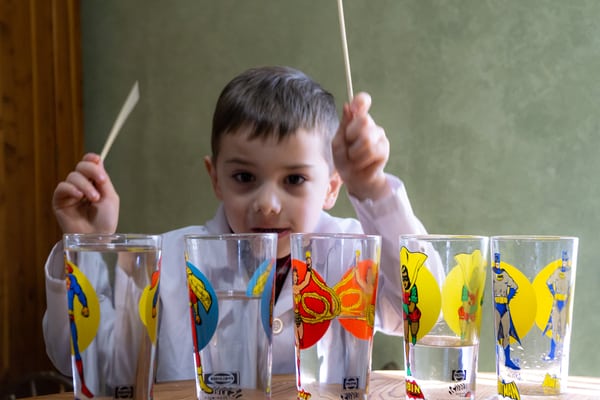
- Drinking Glasses.
- A spoon (or chop sticks)
- Food Coloring (optional)
We can use drinking glasses to make a scale and play music (or just make some noise!) There are 8 tones in a major (or minor) scale, so we can shoot for 8 glasses.
Depending on the size of your glasses, we may need to mix and match different size glasses to find the range of a whole octave. There are a number of factors that affect the tone and pitch, like the size and thickness of the glass. If you don’t have enough glasses on hand, that’s fine; don’t let that stop you. Musicians have written songs and made entire careers of just a few notes! use what you have and make some music.
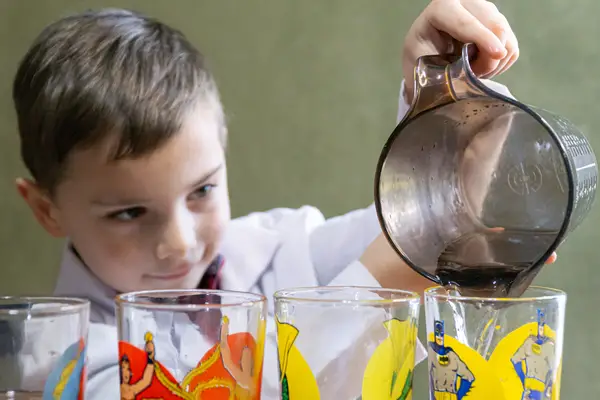
- Line the glasses up in a row.
- The one on the far right mostly full with water.
- Moving to the left, fill the remaining glasses with decreasing amounts of water.
- Tap each glass lightly with a spoon and listen to the tones.
- By adding water or dumping some out of each glass, you can “tune” your glasses. You can use a free app (like Pitchlab on Android or IOS) to help you find the notes and tune.
- For more fun, add a few drops of different food coloring for a rainbow water xylophone.
Notice how the amount of water in each glass affects the pitch. Less water makes a lower pitch, while more water creates a higher pitch. Why do you think that is?
If you have chopsticks, you can try using them like drumsticks to play your glasses.
Try wetting your finger and gently circling it around the rim of a glass. This works best with thinner glassware like wine glasses.
You can do a similar experiment with bottles filled with different amounts of water. If you blow across the top of the bottle, it will produce different pitched noted depending on how much water is in each bottle.
Cup and String Phone
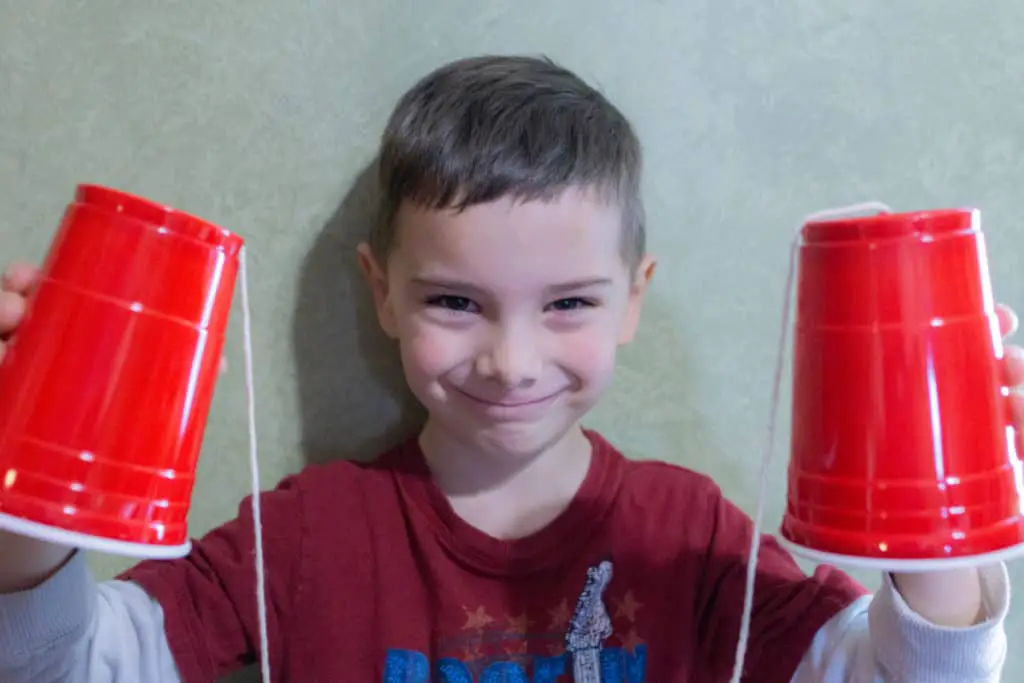
This is a classic, and can be done with plastic cups or tin cans. It’s a great way to experiment with how sound vibrations can travel. We had some plastic cups, which are easier to punch holes in, so this is what we used. Here’s what you’ll need:
- 2 plastic cups
- A piece of string
- A pencil or scissors
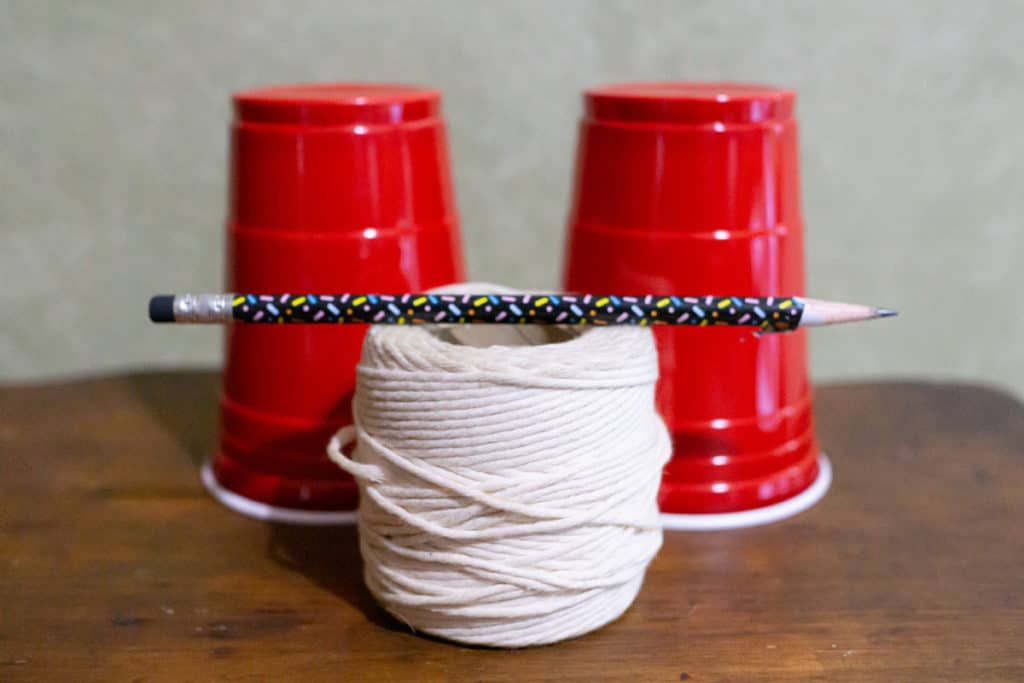
- Use the pencil or scissors to poke a small hole in the bottom of both cups, just enough to fit the string through
- Thread the string through the holes
- Tie knots in the ends of the string so that it does not fall back through the holes
- Give one cup to your friend and hold the other. Pull the cups so the string is tight.
- Have your friend put their cup to their ear and talk into your cup. Now listen as your friend talks back
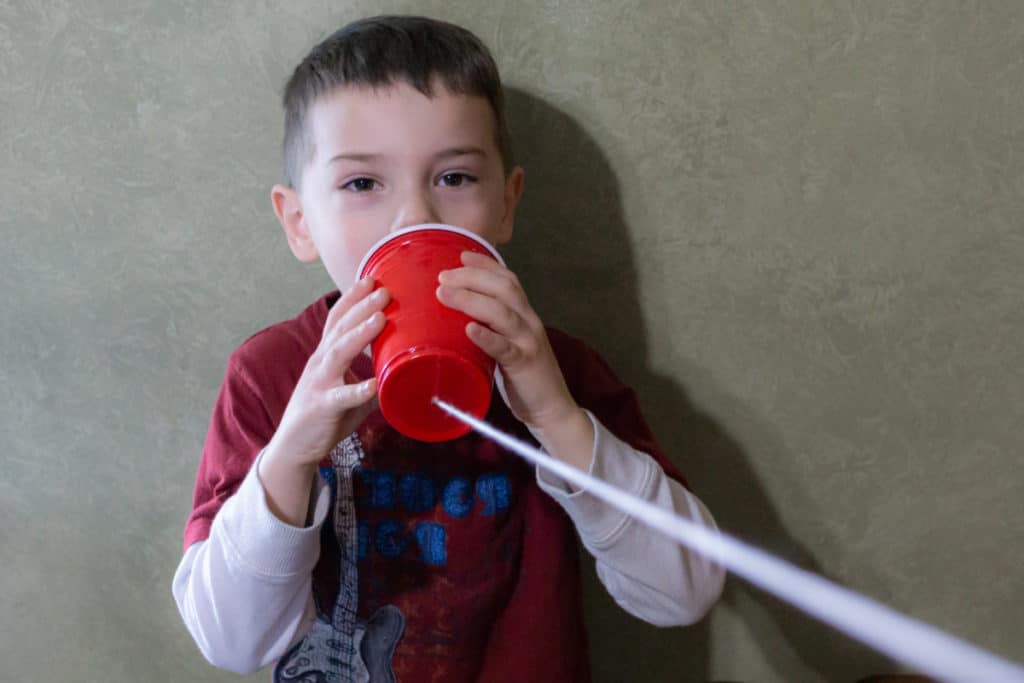
Your voice, like any sound, travels through the air in waves. When you talk into the cup, the sound waves from your voice cause the cup to vibrate. These vibrations are carried along the tight string and into the other cup.
What happens if the string isn’t tight? The sound doesn’t travel nearly as well. Why do you suppose this is?
Related Posts: Check out our full posts on plastic cup projects and activities with household objects for some fun things to do with items you probably already have around the house. Great no-prep ideas for you and your child!
Big Box Bass
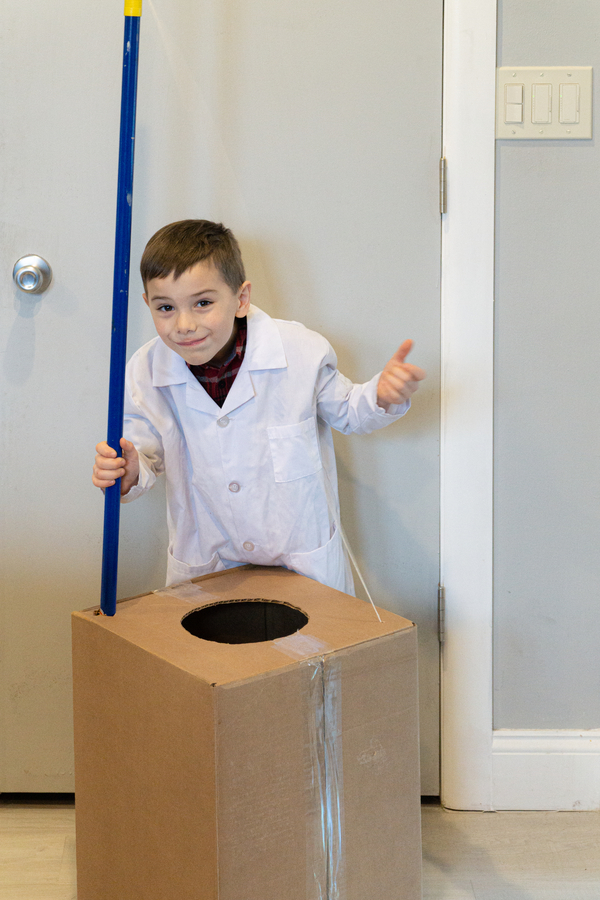
The washtub bass conjures images of old timey jug bands, with DIY home made instruments. Instead of putting a hole in a washtub, we’ll use a large box. The principles at work are the same as our other vibrating string experiments. To make your own Big Box Bass, you’ll need:
- Large cardboard box
- Scissors or utility knife
- Popsicle or craft stick
- Paints or markers (optional for decorating your bass)
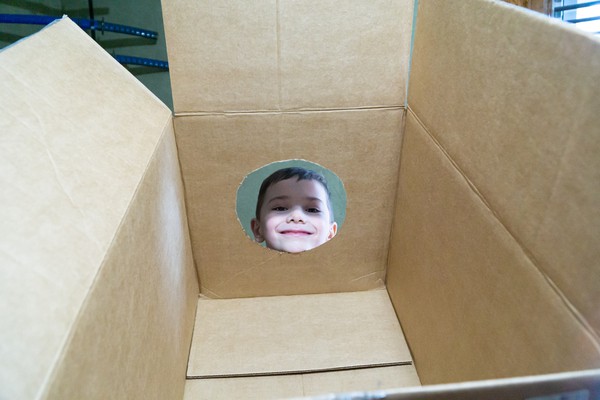
- Cut a hole on the top of the box, about 8-10 inches in diameter. This is the sound hole for our instrument.
- On the top of the box, poke a smaller hole or cut an “x” just large enough to fit the broomstick through
- Slide the broomstick through the hole and let it rest on the bottom of the box
- Attach one end of the string on the top of the broomstick, securing it in place with the thumbtack. Our broomstick had a convenient hole in it so we could just thread the string through and tie it.
- On the top of the box opposite of the broomstick, poke a small hole just big enough to fit the string through.
- Thread the sting through the hole and tie it around the popsicle stick, so that the stick prevents the string from going back through the top of the box
- Use the tape to seal the box.
- Pluck the string, and try moving the broomstick to adjust the tension on the string.
- Decorate or paint your box.
- Get Ready to Jam!
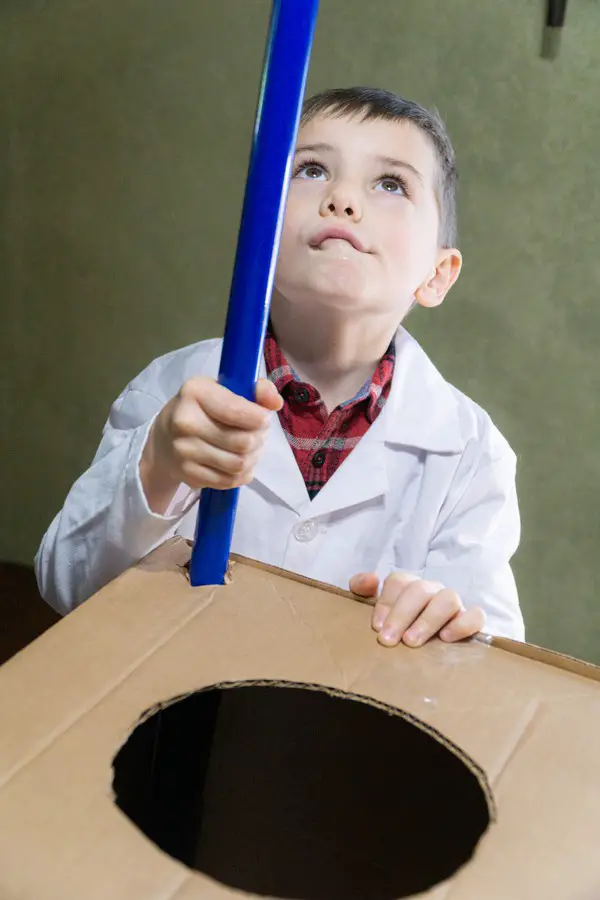
Plucking the string causes it to vibrate. The inside of the box is a resonating chamber, and the hold you cut in the top is a sound hole; much like an acoustic guitar. The tighter the string, the higher the pitch that will be produced. The more slack, the lower the pitch.
We found the box needed some weight inside the box to hold it down while playing it. Free weights, a few bricks, or whatever you can fit inside the sound hole should do the trick. Push down a bit on the broomstick as you play so it is secure on the bottom. Make sure there is tension on the string as you pluck it. Try plucking it and shifting the broomstick so it’s looser or tighter to get some good twangs out of the string.
Practice your music skills and see if you can play a familiar tune.
Sound Tubes
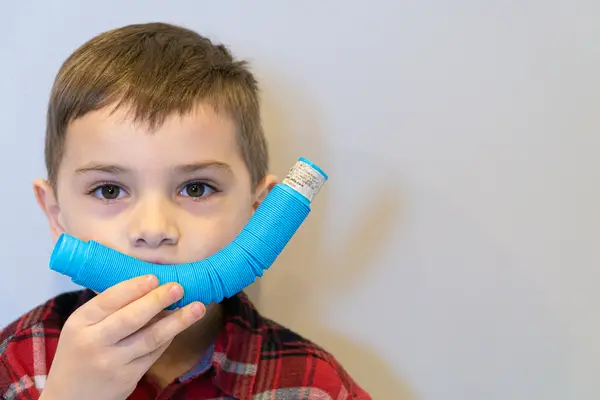
We got some of these “Pull and Pop” tubes for the kids to play with. They’re fun on their own, but we discovered a cool sound experiment playing with them. If you expand a tube all the way and swing it around in a circle, it makes a cool sound. The corrugated shape lends itself well to sound. These kids toys are also known as a whirly tube, corrugaphone, or bloogle resonator.
Our kids thought this was a fun activity, and science demonstrations don’t get much easier: Swing it slowly, and it makes a low pitch. Swing it faster and the pitch gets higher.
We’re hearing the difference in air pressure when swinging the tube. The end of the tube is swinging faster than the end being held, creating a relative increase in air pressure as the tube spins. This effect is known as Bernoulli’s principle. Bernoulli’s Principle tells us as the speed of air increases, the pressure decreases.
As the tube spins, the pressure lowers in the swinging end. The difference in pressure between the two ends of the tube causes air to travel through the tube from the end being held to the end that is swinging. The high pressure air in the fixed end travels through the tube to the low pressure area. The faster the tube spins, the greater the pressure. The air moves faster and increases the pitch.
Pro Tip: If you’re interested in these, get a larger pack . Our kids loved these so much they crinkled them to death, to the point where we couldn’t collapse some of them anymore. They’re great to play with, but will only survive so long.
Stretched Strings
Stringed instruments are capable of producing a wide range of pitches. We’re going to create a simple exercise with one string to experiment with how this concept works.
- A wooden board
- A small bucket or container
- Rocks, stones or weights
- Nylon fishing line
- A popsicle stick or craft stick
- Using the hammer, drive the nail into the top of the board near one end
- Tie one end of the fishing line to the nail
- Cut the fishing line to approximately twice then length of your board
- Tie the other end of the fishing line around the handle of the bucket. With the board resting on a table, arrange it so the bucket hangs over the edge but does not touch the floor
- Place the popsicle stick on its edge on the side of the board opposite the nail, and position the string over it. The string should push down on the stick with the weight of the bucket holding it in place
- Pluck the string and note the pitch of the string
- Add some weight to the bucket, and pluck the string again
- Experiment with different weights
- Now experiment moving the popsicle stick and pluck the string
Adding weight to the bucket increases tension on the string. This makes the pitch higher, like tuning the string on a guitar, ukulele, violin, etc..
Moving the popsicle stick changes the length of the string that is vibrating. Notice how this affects the sound. Think about how this relates to our water glasses in the experiment above, where the amount of water in the glass changed the pitch.
The popsicle stick in this case is like the bridge on a guitar or violin. Adding or removing weight from the bucket is similar to adjusting the tuners. It changes the tension on the string which results in a change in pitch. More tension makes the pitch higher, and less tension gives a lower pitch. This simple principle is what makes stringed instruments work.
What do you think would happen if you tried a thicker fishing line or different string? How would it affect the sound?
Pipe Organ with Cardboard Tubes
We’ll be using a number of cardboard tubes to make a pipe organ. This is similar to an instrument used by Blue Man Group, which you can check out in this video:
Mailing tubes, or tubes from rolls of gift wrap work great. You can also use regular paper towel or toilet paper tubes.
- Cardboard Tubes/Paper Towel Tube
- A flip flop
- Rubber bands or tape
- Cut the tubes into various lengths, roughly 1 inch difference between the tubes
- Arrange the tube longest to shortest from left to right
- Make sure the tops of the tubes are level
- Use the flip flop to strike the top of each tube
If you want to get kick this sound activity up a notch, you can use PVC pipes cut to length instead of cardboard tubes.
DIY Soundproofing
Now that we’ve looked at how sound travels in waves and made a bunch of noise, what about soundproofing? How can we dampen or quiet the sound? We’re going to experiment with some techniques that help diffuse the sound.
We’re going to look at two major factors: Materials and Shape. Have you ever noticed how some rooms or spaces echo sound and some do not? The surface materials have much to do with how sound waves travel within that space. Materials like tile or concrete reflect the sound, while softer materials like carpeting or foam absorb the sound.
Shape works similarly. Flat surfaces bounce the sound waves directly back, while irregular surfaces diffuse the sound by bouncing it back at different angles.
This is why bathrooms or stairwells seem to have echos, while recording studios tend to use foam tiles that look like egg crates. We’re going to use these principles to build a sound proof box, similar in theory to this:

To DIY something similar, you will need:

- Cardboard box
- Several Egg Cartons
- Towels or rags
- Tape or hot glue gun
- A radio, bluetooth speaker, or phone to make noise
- Cut the egg cartons so you have the parts that the eggs rest in. You’ll need enough to line the entire inside of the box
- Use the tape or a hot glue gun to secure the cartons to the sides of the box, as well as the underside of the lid.
- You can fill in any gaps with the towels or rags.
- Place the radio or speaker inside of the box and turn it on so you can hear the noise
- Close the lid of the box
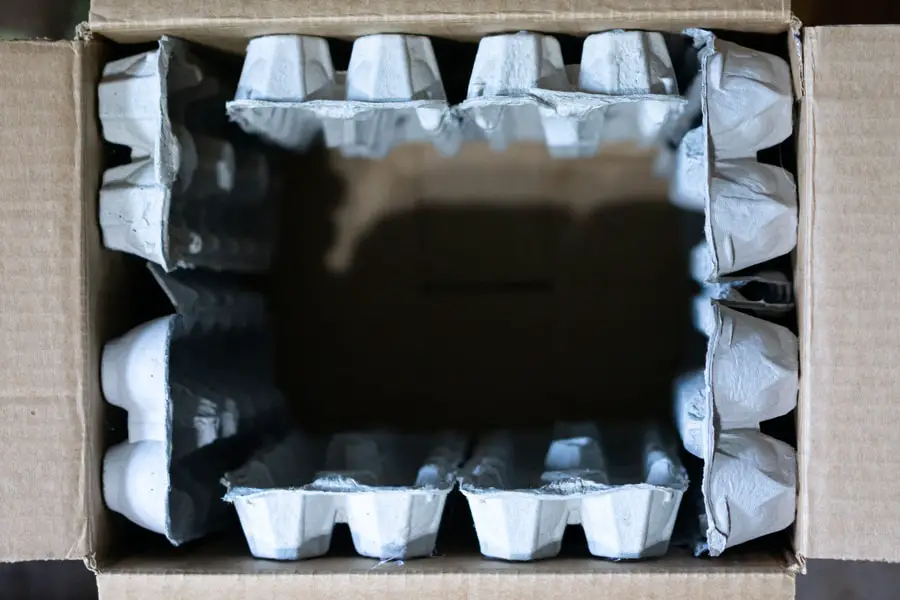
How loud is the noise? Can you hear it clearly, or is it muffled? What’s Happening?
The sound is dampened by the egg carton and towels. The materials are soft, and absorb the sound instead of reflecting it. The surface of the egg carton is uneven and reflects the sound at a number of angles, weakening it.
Science Experiments with Sound – Wrap Up
We hope you enjoyed the science experiments with sound as much as we did. Sound surrounds us and moves through us. It’s not exactly “the Force” that binds the galaxy together, though we often take the effect sound has on us day to day for granted.
With some simple experiments for kids, we learned some of the principles that go into designing many musical instruments and had some fun playing (and making noise.) The kids liked how changing the length of a string or swinging a sound tube faster changed the sound. They also loved to learn that they were in control of it. The idea that their actions change what they hear is powerful. I was surprised how big of a hit the Big Box Bass was, and how that lead to questions about my bass guitar. Once we did the Drinking Glass Bells every dinnertime has had a special performance. Which sound experiment or activity was your favorite?
More Fun Activities
Looking for more fun activities? Sign up for access to our free printable library for some awesome activities for home, home school, or classroom:
Looking for more STEM Projects and Activities? Check out our other STEM Challenges .
About the author
hevanmiller
Latest Posts
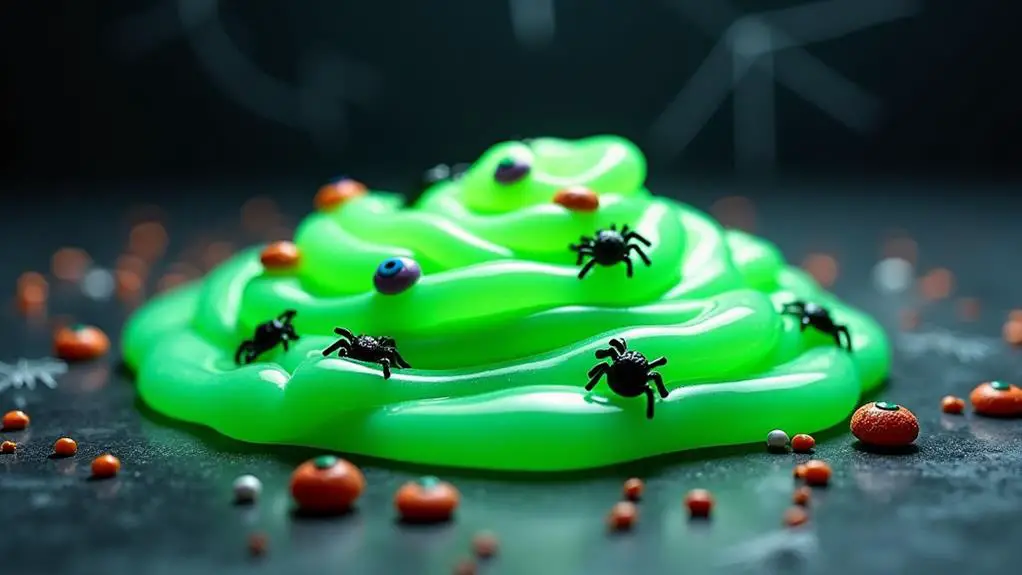
13 Spooky Halloween Slime Recipes
Make your Halloween extra spooky with 13 unique slime recipes that will leave your guests intrigued and eager for more gooey fun.

Best STEM Gifts – Ideas for Kids
Spread the loveWalk through the toy aisle of most stores and you’re bound to come across a wide variety of STEM toys, science kits, and building toys. You can find some inspiration for STEM gifts, but how do you know what to buy? We play with a lot of STEM kits and educational toys; Whether…

Makeblock Robotics & Coding Kits
Spread the loveMakeblock offers a comprehensive range of educational robot kits designed to teach coding, robotics, AI, and STEM concepts in an engaging, hands-on manner. These kits cater to various age and skill levels, promoting creativity, logical thinking, and problem-solving skills. These robots are popular choices for STEM clubs and programs and camp projects. They’re…
7 Cool Sound Science Experiments for Kids
Nov. 19, 2018
When it comes to science experiments, some of the most enjoyable involve the science of sound. If you’re looking to dazzle your little learner with exciting new experiments, look no further than simple sound science experiments that use everyday household items to bring sound to life. Let’s explore 7 riveting ideas to discover the science behind sound! Watch educational videos with scientific experiments and show them to your child.
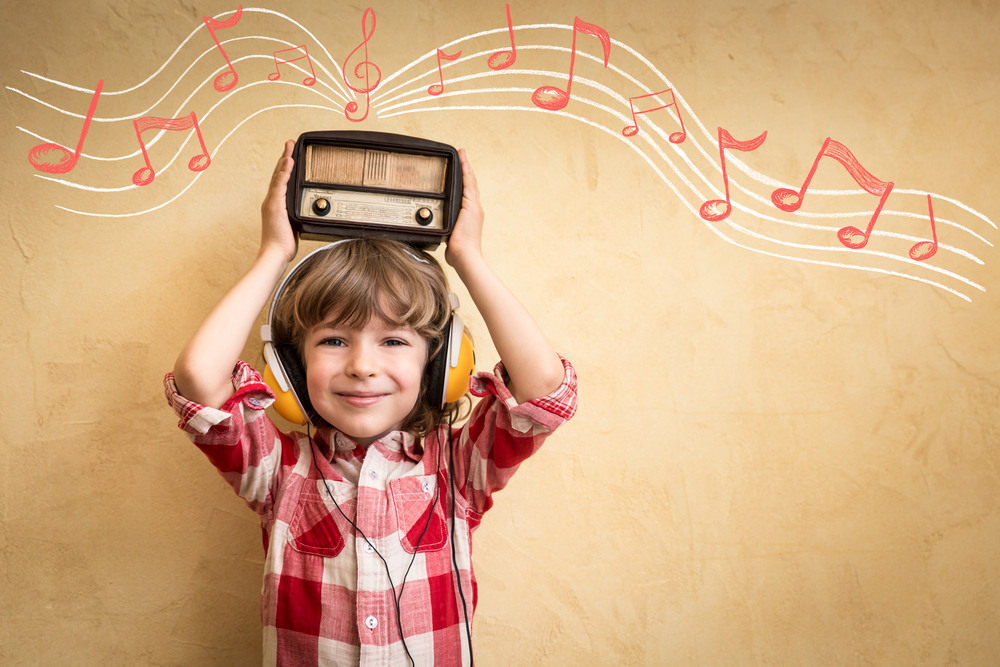
The Classic Paper Cup and String Phone
A much-loved childhood project, the paper cup phone is much more than a fun and old-fashioned way for kids to communicate throughout the house. This elementary sound science project shows kids how sound waves can travel through a string and be converted back to audible sound at the opposite end.
Supplies Needed:
- 2 paper cups
- Long string, like fishing line, kite string
- A sharp pencil or needle to poke holes in the cups
What to Do:
1. Start by cutting a long piece of string of at least 50 feet.
2. Poke a small hole at the bottom of each cup.
3. Using each end of the string, thread it through the bottoms of the cups, tying a large knot so that the string does not fall out of the cup. If you make the holes too large, use a washer or paper clip to hold the string in place so that it does not pull out of the cup.
4. Move into position and encourage your child to move away from you so that the string is far enough to make it tight. Be sure that the string does not touch any other object and that it remains suspended in air as you complete the experiment.
5. Taking turns, talk into the cup, while the other person listens by putting the cup to their ear. Tell your child to repeat what he or she hears after you have spoken and do the same in return!
After the experiment, explain to your child what is happening: sound waves created by talking through the cup travel through the line to the other end, converting back to sound on the opposite side!
Make Music with a Straw Pan Flute
Perfect for younger children, the following sound waves experiment not only involves creating a fun musical instrument your child could play with, but teaches kids how length can affect the pitch of sound waves.
Supplies Needed:
- At least 9 or 10 straws, more if desired!
- Clear gift wrap tape
1. Take the straws and line them up side-by-side and cut them at an angle at the top.
2. Tape the straws together to make a pan flute.
3. Instruct your child to blow through the straws. Which straws make higher and lower pitches? Why?
Feel free to use more straws and experiment with different lengths to produce different pitches and sounds! Ask your child to explain what happens to the sound the shorter a straw is cut, and create double pan flutes to make harmonies to further explore how length alters the pitch.
Listen to Sounds Travel Underwater
Sound travels well through air, but it travels even better through water! This easy sound experiment for kids can be done in a jiffy out on the back porch.
- A bucket filled with water
- A large plastic water or soda bottle
- At least 2 kitchen knives
- Scissors or sharp knife to cut the bottle
1. After filling the bucket with water, take a sharp knife or kitchen shears and help your child cut off the bottom of the plastic water bottle. Be sure that the cap is taken off of the bottle.
2. Instruct your child to place the bottle in the water so that the cut bottom is in the water. Your child will then put his or her ear to the top of the bottle to listen.
3. Using the kitchen knives, clang them together to make a sound, but do this in the bucket as your child is listening. What does your child hear?
Your child has probably noted that the sound of the clanging is loud and clear. Water travels faster through water than in the air, and animals that live underwater are able to hear sound clearly. Discuss the results with your child, to teach him or her more about the conduction of sound waves through water.
See the Sound
Sound vibrations travel through air, water, and even solid objects, but it’s not possible to see the waves. What if we could see the waves in another way? This science of sound experiment makes sound more visible by forcing objects to react to the sound vibrations.
- Empty clear mixing bowl
- Plastic wrap
- Large rubber band
- Sugar crystals- Sugar in the Raw works great, or make sugar crystals in another science experiment!
1. Wrap a sheet of plastic wrap over the mixing bowl so that it’s taut, and secure with the large rubber band. Be sure that the plastic wrap is tight and does not sag.
2. Place a few of the sugar crystals on the top of the plastic wrap, placing them in the middle of the wrap.
3. Instruct your child to get close to the sugar crystal and say something loudly! What happens to the crystals? Do they move?
4. Experiment with louder and softer words or sentences to watch the sugar crystals react to the sound vibrations!
While your child might think it’s his or her breath making the crystals jump and move, but it’s actually the sound vibrations. Try different sounds besides ordinary speech and see how the crystals come to life!
Make a Stick Harmonica
Making musical instruments are easy and fun, and they teach kids about sound waves and pitch. This experiment is much like the pan flute above, but kids can alter the pitch by sliding the straws without reassembling the harmonica.
- 2 large craft sticks
- 1 wide rubber band
- 2 smaller rubber bands
- 1 plastic drinking straw
1. Using the scissors, cut the straw into 2 one-inch pieces and set aside.
2. Take the wide rubber band and stretch it length-wise around one of the jumbo craft sticks and place one of the straw pieces under the rubber band, close to the edge on one end.
3. Take the other craft stick and place it directly on top of the craft stick with the rubber band. Secure them together at the ends using the small rubber bands.
4. Finally, take the last piece of straw and place it in the harmonica between the sticks on the opposite end from the other, but this piece should be fit above the wide rubber band instead of below it.
5. Encourage your child to play the harmonica by blowing in the center of the harmonica! Explore different pitches by moving the straw pieces!
After playing the harmonica, don’t forget to complete the sound experiment by talking about the mechanics of the harmonica. The vibrating rubber band makes all the noise, and the closer the straw pieces are to the center of the harmonica, the higher the pitch will be due to the shortened length of the band!
Experimenting with Sound Waves
It might be hard to imagine that sound waves can travel through solid objects as well as through the air. This simple but exciting sound waves science activity will demonstrate for your child how sound can and does indeed travel through solid objects!
- Metal kitchen spoon- a large metal measuring spoon works great!
- At least 30 inches of kite string
1. Stretch out the string and tie the handle of the spoon in the middle of the string.
2. Take one end of the string and tie around your child’s pointer finger. Do the same using the other end, but tie this string around the pointer finger of your child’s opposite hand.
3. Instruct your child to put his or her fingers, with the string wrapped around each, into their ears.
4. Help your child lean over so the spoon dangles and help him or her swing the spoon so it hits a nearby door or wall.
5. Hit the door or wall again, but this time with more force. What does your child hear?
Your child should hear a bell-like sound travel up the string from the spoon and into their ears. Discuss with your child how the sound waves created from the spoon hitting the door moves through the string until he or she is able to hear it!
Xylophone Water Jars
Musical instruments are so much fun to make! This sound activity teaches children how varying levels of water in containers change the pitch of the sound created.
- 4 empty and clean baby food jars
- 4 different colors of food coloring
1. Help your child fill each jar with varying amounts of water.
2. Add a few drops of food coloring to each jar.
3. Using the mallet, instruct your child to firmly tap the outside of each jar. What sounds are being made? Which jars have the highest or lowest pitch?
Encourage your child to hypothesize why some jars emit a lower sound, while others are higher. Play around with the water levels in each jar and experiment with pitch!
Learn Science with Kids Academy Classroom!
Use this interactive Classroom by Kids Academy called Sound is All Around Us to teach first graders the basics of sound science. OPEN THE CLASSROOM .

After clicking "Next", you'll find a set-up lesson with an educational video, accompanied by practice worksheets and summary quiz to help kids better understand and remember the learned material.
Equipped with our extensive learning resource library, Kids Academy Classroom allows teachers and parents to create lessons and share them with the young smarties in a couple of clicks.
Go directly to the Classroom page and create a quick classroom on any topic you want! After students complete the lesson, you'll get access to a report about their performance. Check out our Classroom Guide article for more information!
Now that you have 7 cool ideas for exciting sound science experiments, it’s time to get started! Your child will love learning all about the science of sound and the endlessly fascinating ways sound waves can travel through air, water, and objects. Don’t forget to check out our science worksheets and activities to supplement your child’s learning in between all your child’s experiments!
Related Articles

Cancel anytime
You'll be able to manage the favorite spreadsheets list.
You’ll be able to hide/mark the accomplished tasks.
- School / District Account
- Family Account
- 2 PDF worksheets per day
- Interactive worksheets
- Targeted ads
- KidsAcademy ads
$ 1.99 / month
- Printable and interactive worksheets
- Learning videos
- Ad-free browsing

- Engage students and save time with ready-to-use premium educational activities.
- Unlimited Learning Library access
$9.99 / month

Posted on Last updated: November 24, 2020 By: Author Kim
Categories STEM Activities
How Did You Hear That? Simple Sound Science for Kids
Simple Sound Science Activities for Kids
Let’s talk about sound. My children are very familiar with it, at least they are quite good at volume. Kids are really great at producing sound, and most of them enjoy being loud.
So why not take advantage of that interest and talk about how sound works. How do we hear sounds? What are sound waves? Can we see sound? Give your children an excuse to be loud for an afternoon. Here are 4 easy and fun sound science experiments for toddlers and preschoolers.
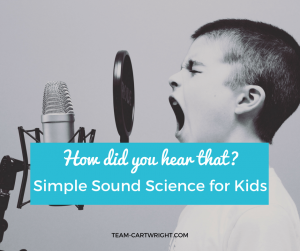
What's In This Post?
What are Sound Waves?
How does sound work.
Before we get into the fun activities, let’s learn a bit about how sound works.
What is sound? Sound is carried by waves, not unlike the waves we looked at when we learned about color . These waves require a medium to travel through, which on earth is the atmosphere that surrounds us.
We can’t see them, but there are millions of molecules floating around everywhere. These molecules transfer energy, which is how a wave moves.
This is the same way colors move as waves through the atmosphere. The difference between sound and color is that color comes from light waves and sound waves come from vibration.

Sounds originate through some sort of vibration. Think of hitting a gong. When you strike it, it vibrates. These vibrations are energy waves that travel through the air.
Only unlike color, which is perceived with the eye, these waves interact with our eardrums. Our eardrums vibrate and pass on the waves to our inner ear, where our brain can perceive it as sound.
(There is more to the anatomical part of hearing, but our focus right now is on the sound waves outside of the ear.)
Want more wave science? Learn how colors work!
Properties of Sound Waves
There are two big properties that describe sound waves: frequency and amplitude .
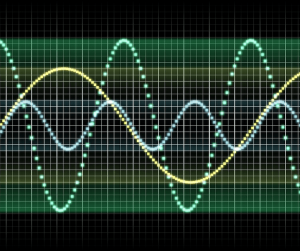
Frequency is how quickly the wave is moving. Is it a quick vibration that created the sound, or a slow one?
Frequency impacts pitch. A fast frequency will create a higher pitch. A slower frequency has a lower pitch.
This is a great time to explain pitch to little ones too. It’s easy to demonstrate. Speak in a high voice (like you just had some helium), this is a high pitch. Have your child try it. Then have them speak in a very low voice (I told Ben to talk like Daddy), this is a low pitch.
Amplitude is how big the wave is, and this affects volume. (This is where the word amplifier comes from.) A big wave will have a loud sound. A small wave will have a quiet sound.
Here is an example to help visualize these. Think of a great big gong. When you hit it big slow vibrations are created. It makes a deep, loud sound. This is because it has big waves that are moving slowly.
Now think of a tiny gong. When you hit it you create small fast vibrations. It makes a high sound and is quieter than the big gong. This is because it has small waves moving quickly.
See waves in action with science by the pool.
Sound Wave Activities
Now that we know a bit about how sound waves work, let’s explore them in action!
Balloon Amplifier
Want to make the world’s easiest amplifier?
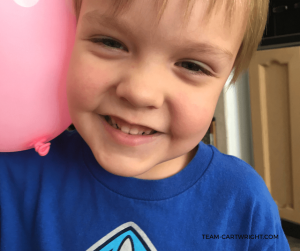
Blow up a balloon, hold it up, and tap on it. It doesn’t make a super loud sound. Next, hold the balloon up to your child’s ear and lightly tap on it. It sounds pretty loud!
Why does this happen? When you blow up a balloon you are packing it with air molecules. They are very close together and transmit sound waves super well compared to the air just around us normally.
When we tapped the balloon while we were just holding it those waves had to move through the less compressed ambient air to get to our ears, and the sound is softer.
When we hold the balloon up to our ears the sound just has to get through the tightly packed molecules in the balloon and we hear a louder sound. It is amplified.
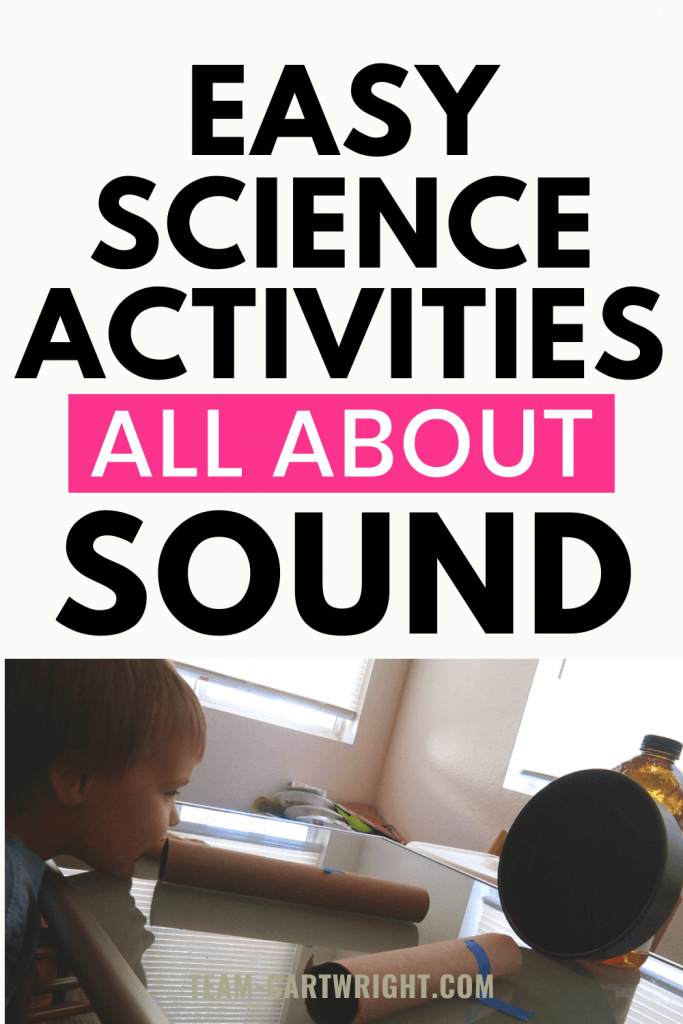
Can you see sound? Well, we can’t see the sound waves as they move through the air. (Though picture the waves you see when you drop a rock into water. They look a lot like that!) But we can see the vibrations that create sound transmitted between surfaces with a little help.
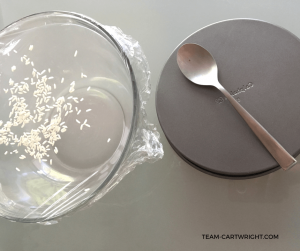
- Plastic Wrap
- Uncooked Rice
- Metal Spoon
Put the plastic wrap tightly over the bowl. (One sheet, as tight as you can get it.) Put about 1 teaspoon of rice on the plastic.
Then hold the metal pan close to the bowl and have your child hit it with the spoon. The harder they hit it the better. The rice will dance!
What is happening is that the pan vibrates, creating a sound wave. This wave is transmitted through the air molecules and cause the plastic wrap to start vibrating as well, making the rice dance!
You are seeing the result of the sound waves in the rice. Are any patterns formed? Try hitting the pan harder and then more gently. How does the behavior of the rice change?
If you want to be a cool mom see if your child can hit the pan hard enough to bounce the rice right off the plastic!
Transmit Sound Through String
Remember making telephones with your friends using cans and string? Yeah, me neither. I’m not that old. (And how did kids drill holes in the cans anyway?) But we can use this idea to show kids how sound travels through a medium.
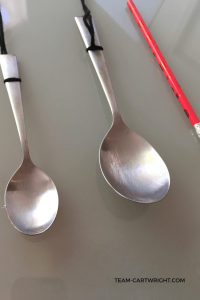
- A Long Piece of Yarn
- 2 Spoons of Different Sizes
Take the yarn and tie it around the spoon so the spoon is in the middle of the piece. Take the two long pieces on either side and have your child hold them up to their ears.
You want to bunch up the string loosely and have them put it in their ears. Not too far (safety!), more like you are just trying to block out other sounds. Then tap on the spoon with the pencil. And watch their faces.
Hitting the spoon with the pencil causes the spoon to vibrate. Remember, sound needs a medium to travel through, and in this case, the yarn is that medium. It transmits the sound directly to your ears.
What makes it so much louder? In an open room, sound waves transmit in all directions. So what you hear is not everything that is being produced. Air molecules are not very tightly packed, which also makes the sound less intense.
With the yarn most of the wave is being sent right to your sound receptors, making it more distinct and louder.
Have your child try the other spoon. How do the sounds compare? Try different lengths of string. What does that do to the sounds?
Want to make more music? Here are 5 easy DIY instruments to make at home!
How Do Echos Work?
How do echoes work? What makes you hear a sound a second and third time like that?
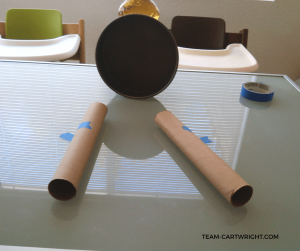
- 2 Paper Towel Tubes
Prop the pie pan up on a table so it is vertical. Take one paper towel tube and place it on the table, angled a bit but aimed at the pie plate. Take the other paper towel and have it angled the opposite way, also aimed at the pie plate.
Have your child put his ear to one of the tubes while you talk softly into the other. You can hear what is said through the other tube!
The sound waves you create by speaking travel through the tube. They are directed through the tubes, hit the pie plate, and bounce off, traveling back through the other tube. You are hearing the echo.
An echo is when a sound wave bounces off of a surface. Some surfaces are better for echoes than others. For example, bathrooms are often very good at creating echoes. This is because they are usually full of hard surfaces like tile that bounce back sound waves effectively. A fun bath time activity is to explore your echo with your child.
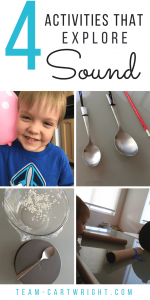
These are simple and fun ways to demonstrate how sound waves work with kids. And you don’t have to stop with these. Make some musical instruments and see what other vibrations you can create. (This is also a great sensory activity. Learn why those are so important: The Big Benefits of Sensory Play )
Take a nature walk and tap on things with sticks. Try making high pitches and low pitches. Explore echoes. Sounds are all around us. Encourage your kids to take a listen and explore the science behind the sound.

Find your next fun activity!
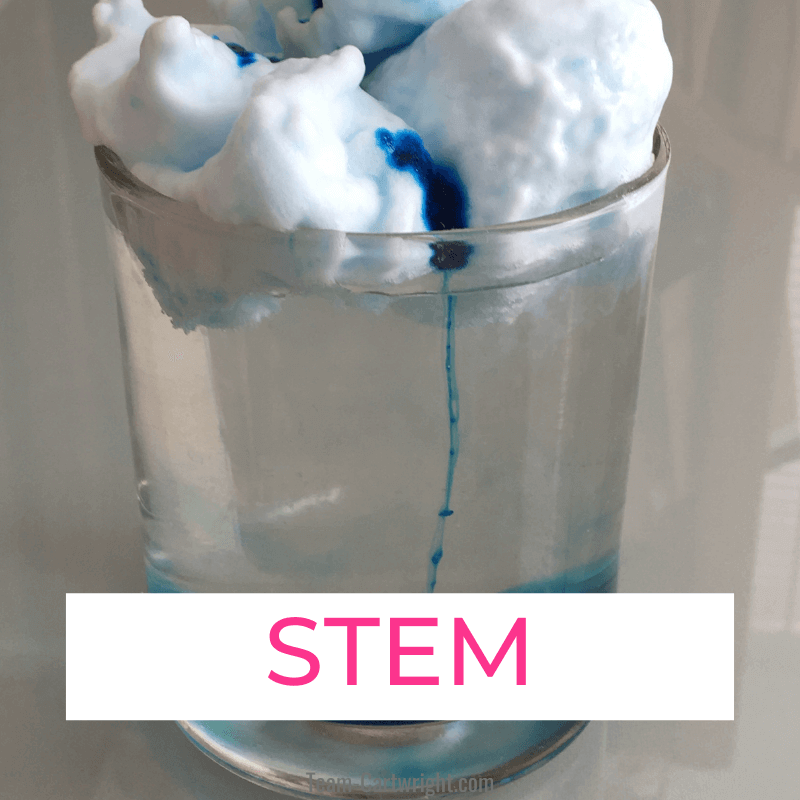
How useful was this post?
Click on a star to rate it!
Let us improve this post!
Tell us how we can improve this post?

* Checkbox GDPR is required
This site uses Akismet to reduce spam. Learn how your comment data is processed .
Sunday 24th of March 2019
My son absolutely loved these activities! We had a spoon on a string for days. Thank you so much for the ideas, it made our preschool time fun.
I'm so glad he liked it! We love the spoon one too. It's so exciting when our kids get into STEM!
Monday 9th of July 2018
These are wonderful activities! My girls are going to love learning about sound!
Saturday 23rd of June 2018
These are such fun and easy sound experiments! Great ideas.
kimcartwright
They were fun! It's cool to look at something we experience every day in a new light.

The Science of Waves: Awesome Sound Experiment for Kids
By: Author Jacquie Fisher
Posted on Published: April 16, 2019
Categories Kids Activities & Crafts , Science Experiments
One of the coolest sound wave experiments your kids will ever try!
We love doing simple science experiments and every once in a while, we find a GEM.
It’s a simple, easy and pretty awesome experiment that explores the science of sound waves and how they travel .
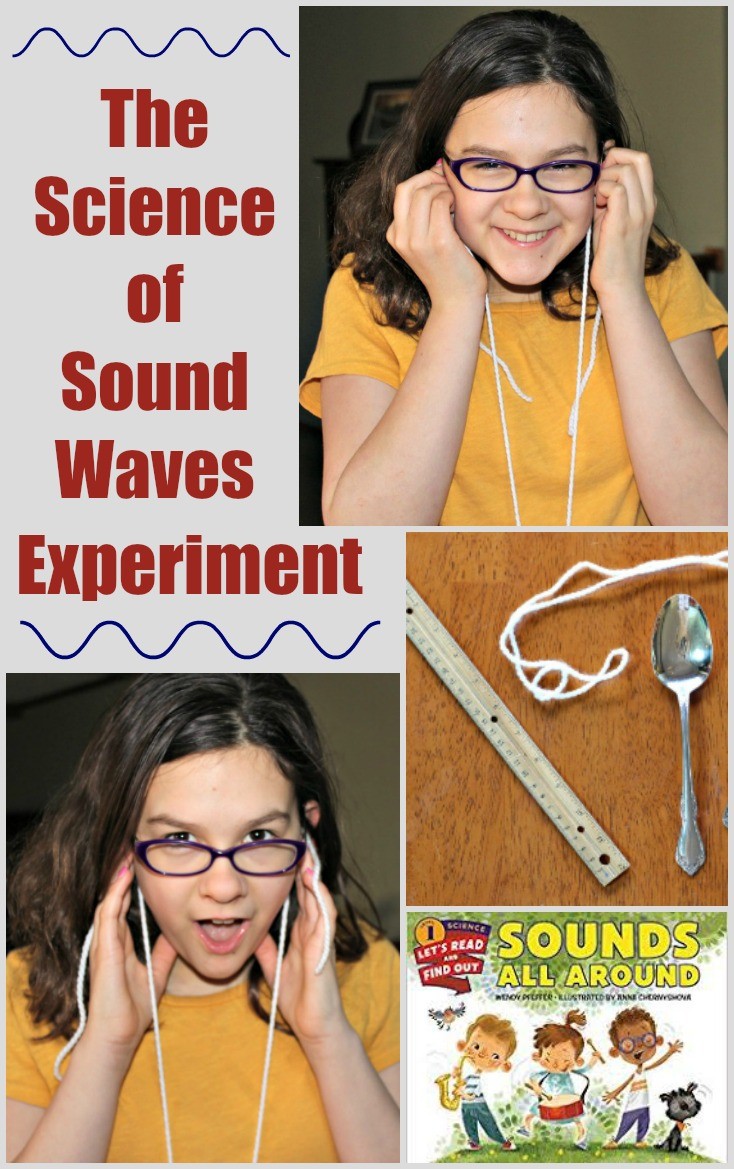
Sound Experiment for Kids
So many of the science activities we do are ones that I’ve experienced before but are new to our kids.
And honestly, as they approach Middle School age, it’s getting harder and harder to impress them 😉
But THIS ONE!
This is one of those really cool experiments that they thought was super cool and even I was impressed with ( and as my husband will tell you, I’m not easily impressed 😉
I should have titled this “ Make Your Own Gong Using a Spoon and Fork ” — because that’s exactly what you’ll get to do!
Like our How does a Leaf Breathe? experiment , this sound wave project also explores the invisible side of science.
As you begin this vibration experiment, explain to your kids that you are going to test how sound travels.
They may not realize that when a ‘noise’ is made, it creates sound waves (which are not visible) that travel through the air and to our ears.
As with any of our experiments, we always start with a good book to help explain the science concepts!
Books about the Science of Sound Waves

Here are a few great books to pair with this activity along with affiliate links so you can easily learn more about each one:
Sounds All Around (Let’s-Read-and-Find-Out Science 1) is part of an amazing science book series that cover all the topics under the sun! This book explains how sound waves travel, how your ear receives sound and answers for more of the questions kids will ask.
And another fun book, What’s That Sound (Science Solves It! ) has facts & activities related to sound – perfect for kids ages 6 – 10 years old.
Sound Experiments for Kids
You’ll need a few items that I’m sure you can easily find around the house — the affiliate links in our list will give you a quick description of each item:
- A ruler (we found a wooden or heavy plastic ruler worked best)
- Two different size spoons (try using a teaspoon and a serving spoon )
- About 4 feet of string or yarn (this will depend on how tall you are as you can see below)
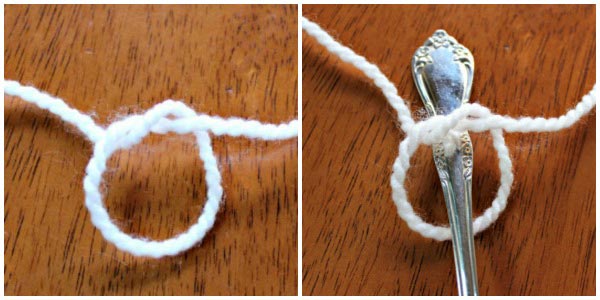
First, create a loop in the middle of the yarn/string and insert the handle of the spoon.
Pull tightly so that the spoon hangs in the center of the yarn/string and you have two long pieces of approximately equal length.
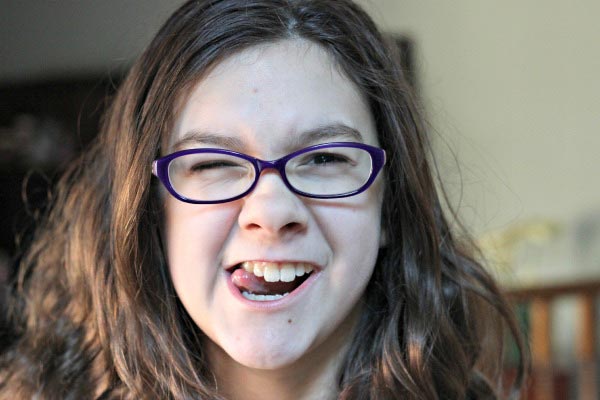
Then make a face at your Mom when she asks to take your photo ( this is an optional step, of course ) 🙂
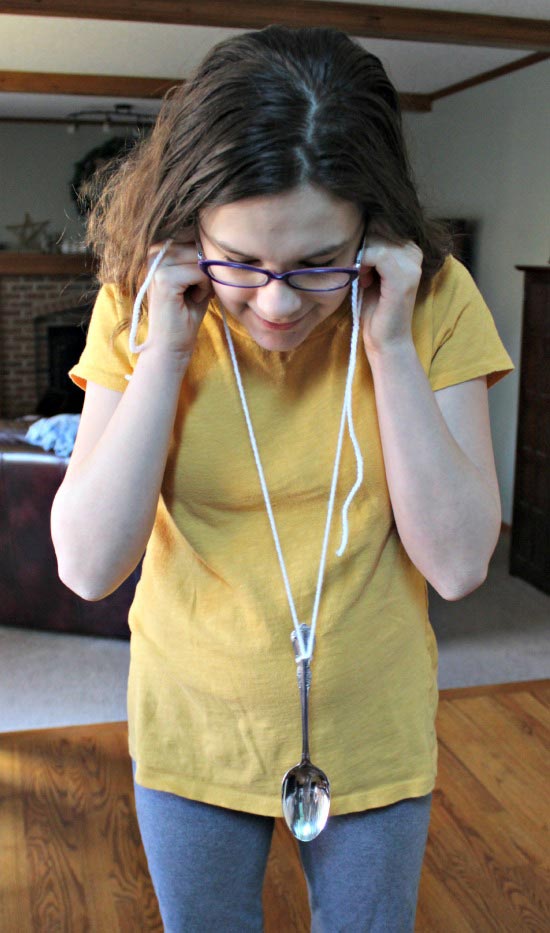
Take each string and wrap them around your pointer finger on each hand.
Then push the string against each ear (not into the ear but just outside like you are going to plug your ears because you don’t want to hear your Mom ask you to do your chores 🙂
You’ll want the spoon to hang just below the waist once both ends of the yarn are placed near the ears.
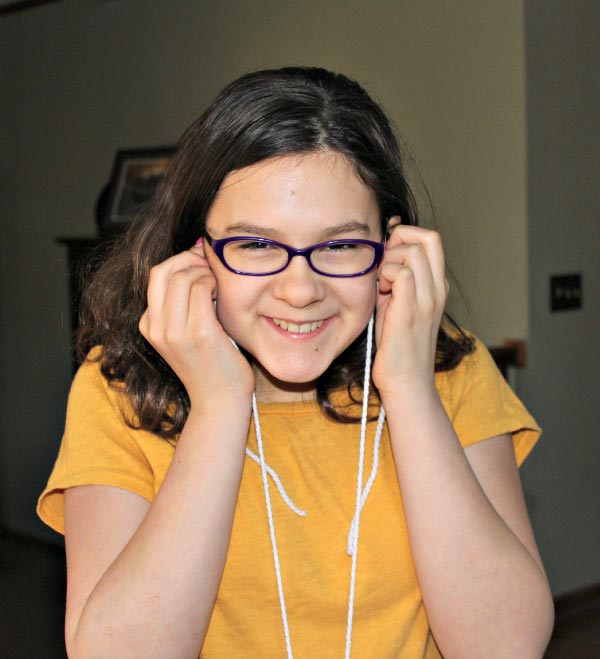
You can see in this photo that you don’t have to use the end of each piece of yarn/string — in fact, as you do the experiment, change how high or low the spoon hangs to see if it changes the sound.
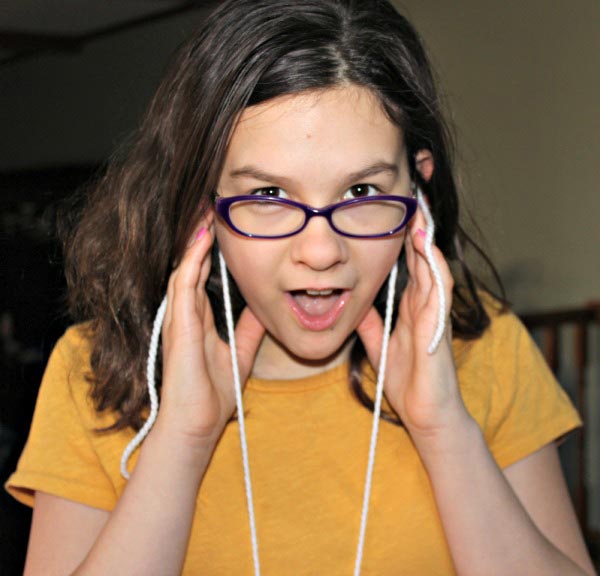
Ok, here’s the big moment …
Once the string in pushed against the ears, have someone GENTLY hit the ruler against the round part of the spoon — and watch the look on your child’s face (priceless!)
Warning : Kids often think that the HARDER they hit the spoon, the louder the sound — be sure to test out this theory too!
If you are using a small spoon, you should hear a distinct bell sound — with a larger spoon, it will sound more like a gong.
Pretty cool!
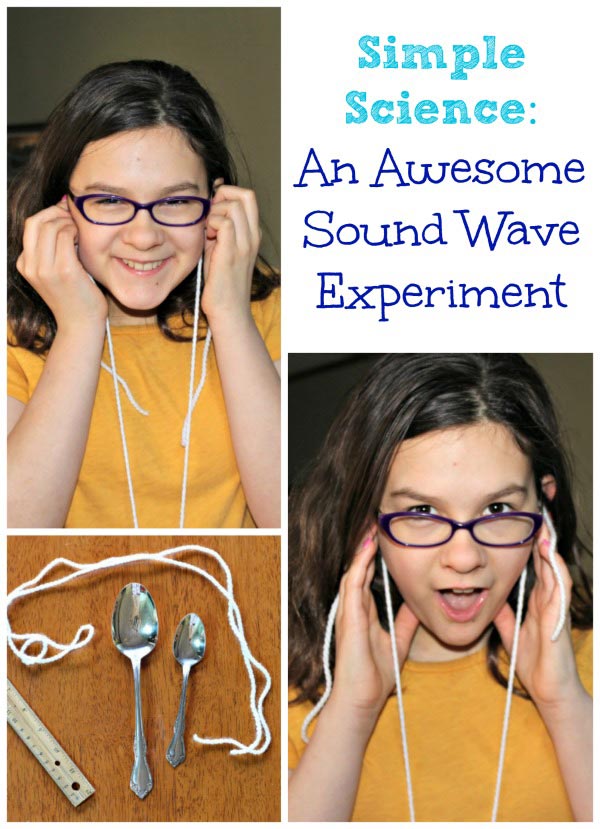
The Science Behind Sound Wave Experiments
Here’s what’s really happening during the activity — I’ve highlighted some of the science terms that you can introduce to kids when discussing this experiment:
When the ruler hits the spoon, it creates vibrations which make sound waves. These sound waves travel up the yarn/string and to the ear instead of just spreading out into the air around you.
The yarn acts as a conductor — an object that allows sound waves to travel.
Depending on the size of the spoon and the length of yarn, the sound will appear higher (like a church bell) or deeper (like a gong).
And because the yarn allows the sound waves to continue to travel, the sound of the spoon will resonate or reverberate — meaning they will continue for a while after you have hit the spoon.
Another thing we found was that the only one who can hear the bell or gong sound will be the person with the string near their ears — which we thought was also pretty cool.
Everyone else in the room will just hear a faint ‘tink’ when the ruler hits the spoon.


More Ideas for Sound Experiments
Ok, we wanted to play around with the experiment a little more — so we also used a serving fork (which is larger than a regular fork).
Do this too and you’ll see that the tines on the fork create a totally different sound.
You can also try different types of yarn/string — you’ll find that the more dense the string, the better the sound will travel.
For more sound wave experiments, try
- the Geeker Speaker Lab Kit which shows you how to make sound waves visible with 5 different experiments!
- the Science of Sound box from Steve Spangler includes up to 10 sound experiments kids can do !
And don’t forget to see all of our simple science experiments!
If you’re looking for more ideas that explore sound waves, try these items:
More Human Body Science Experiments
Fingerprint Science for Kids
How Long are Your Small Intestines?
Looking for more Easy Science Experiments? Try these!
How do Leaves Breathe?
How much Water is in Snow?
Does Your Food Sink or Float?
27 Simple Science Experiments
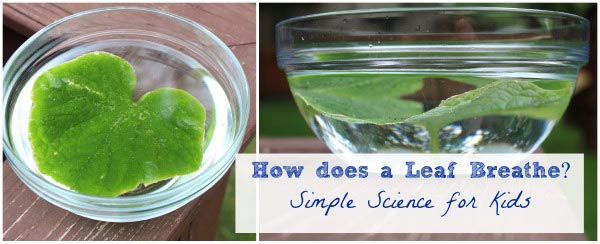
You might also like:
20 Science Experiments in a Jar
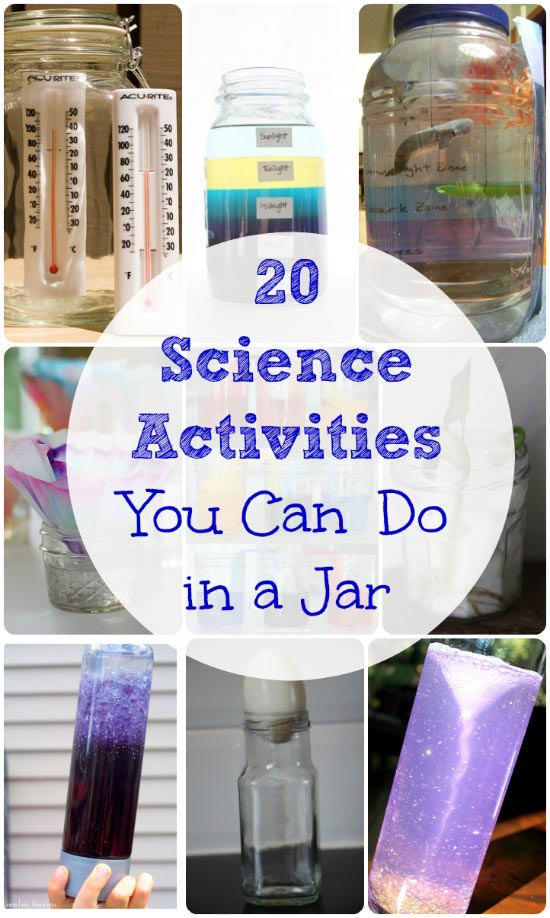
Get Your ALL ACCESS Shop Pass here →
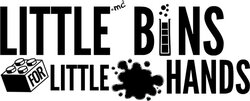
Water Xylophone Experiment
Science truly surrounds us even in the sounds we hear! This water xylophone experiment is truly a must do science activity for young kids. So simple to set up, it’s kitchen science at it’s finest with plenty of room to explore and be playful with it. Try this easy sound waves experiment with water in glass jars for a hands-on science project for kids.

Explore Sounds Waves With Water
Have you ever heard of the phrase kitchen science? Ever wondered what it means? It’s probably pretty easy to guess, but I will share anyway! Let’s show our kids how cool it is to play with science.
Read more below on how you can extend this sound science experiment, add in the scientific process, and create your own sound waves science experiment.
Kitchen science is science that can come out of the kitchen supplies you have! Easy to do, easy to set up, inexpensive, and perfect science for young kids. Set it up on your counter and go!
For several pretty obvious reasons, a homemade water xylophone experiment is the perfect kitchen science! All you need is mason jars {or other glasses}, food coloring, water, and set up chopsticks or even a spoon or butter knife to explore sound.
ALSO CHECK OUT: 30 Water Experiments For Kids
Did you ever wonder how to make science easy enough to do at home or with a larger group of kids, this is it! We love sharing the simplest of ideas to get you started and comfortable with sharing science with your kids.
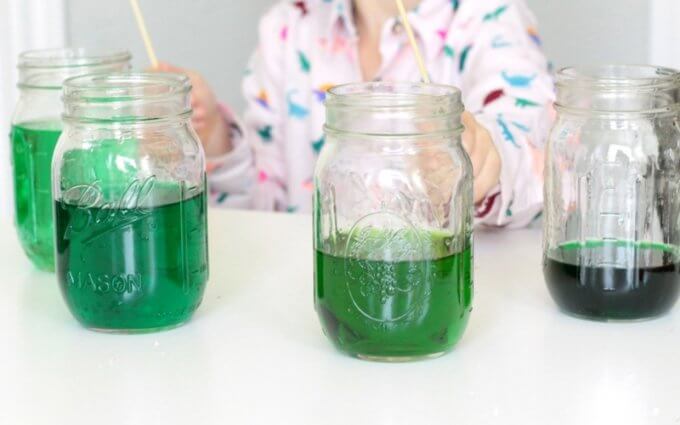
What Is The Scientific Method For Kids?
The scientific method is a process or method of research. A problem is identified, information about the problem is gathered, a hypothesis or question is formulated from the information, and the hypothesis is tested with an experiment to prove or disprove its validity.
Sounds heavy… What in the world does that mean?!? It means you don’t need to try and solve the world’s biggest science questions! The scientific method is all about studying and learning things right around you.
As children develop practices that involve creating, gathering data evaluating, analyzing, and communicating, they can apply these critical thinking skills to any situation.
READ MORE HERE: Using The Scientific Method with Kids
Note: The use of the best Science and Engineering Practices is also relevant to the topic of using the scientific method. Read more here and see if it fits your science planning needs.
Helpful Science Resources To Get You Started
Here are a few resources that will help you introduce science more effectively to your kiddos or students and feel confident yourself when presenting materials. You’ll find helpful free printables throughout.
- Best Science Practices (as it relates to the scientific method)
- Science Vocabulary
- 8 Science Books for Kids
- All About Scientists
- Science Supplies List
- Science Tools for Kids
- Join us in the Club
Get your free printable science guide!

How Does A Water Xylophone Work
When you tap the empty jars or glasses, they all made the same sound. Adding different amounts of water changes the noise, sound, or pitch.
What do you notice about the amounts of water versus the sound or pitch that is created? The more water, the lower the pitch! The less water, the higher the pitch!
Sound waves are vibrations that travel through the medium which in this case is water! When you change the amount of water in the jars or glasses, you also change the sound waves!
Make sure to have your kids tap the empty jars first to get an idea of the starting sound! Have them predict what will happen when they add water. They can also create a hypothesis to explain what happens when more or less water is added. Read more here on the scientific process for young kids .
- Food coloring (we used blue, yellow and green for varying shades of green)
- Wooden sticks (we used bamboo skewers)
- 4+ mason jars
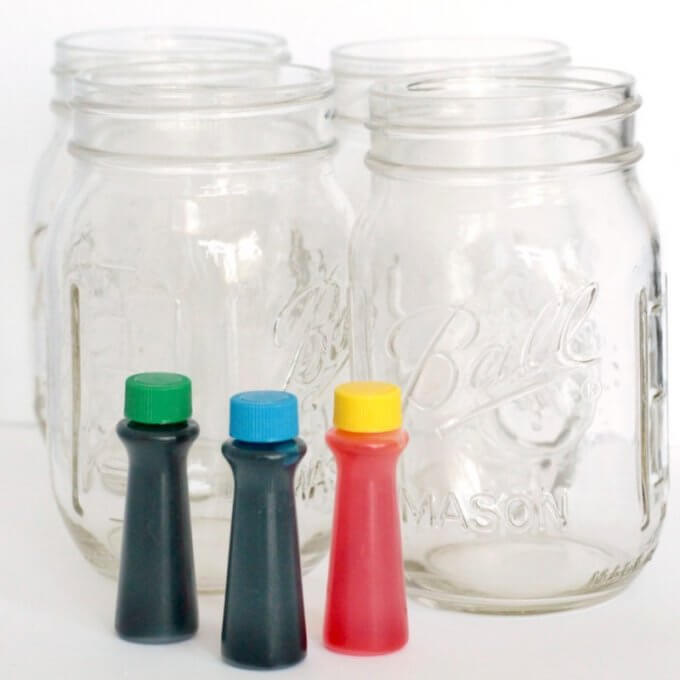
Instructions:
STEP 1. Fill the jars with varying levels of water. You can eyeball the amounts or grab the measuring cups and get a little more scientific with your exploration.
STEP 2. Add food coloring to make different colors for each note. More water equals lower sound or pitch and less water equals a higher sound or pitch. We made our jars pure green, dark green, blue-green, and yellow-green!
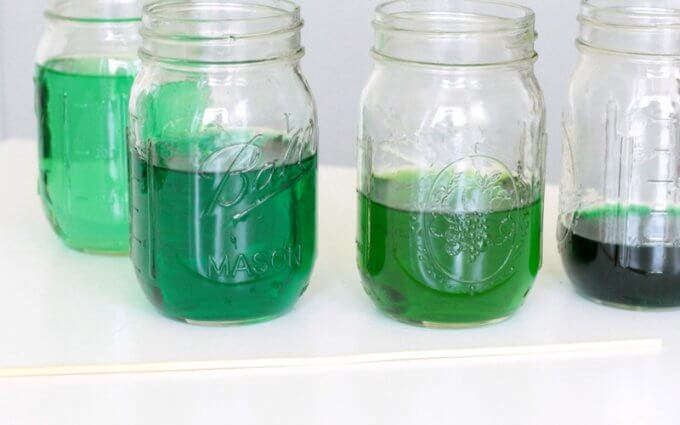
Things To Try With Your Water Glass Xylophone
- Does tapping the sides of the jars make a purer sound than tapping the tops of the jars?
- Try adjusting the water levels to create new sounds.
- Try using different liquids and compare results. Different liquids have different densities and the sound waves will travel differently through them. Fill two jars the same amount but with two different liquids and observe the differences!
- Try using different tools for tapping the glasses. Can you tell the difference between the wood chopstick and a metal butter knife?
- If you want to get super fancy, you can use a tuning app to raise or lower the water level to match specific notes. We tested out this on e a little bit although we are not music experts over here, it’s a fun way to take the experiment a step farther for older kids.

More Fun Ways To Explore Water Science
- What dissolves in water?
- Can water walk?
- How do leaves drink water?
- Great skittles and water experiment: Why don’t the colors mix?
- What materials absorb water
- How does water refract light?
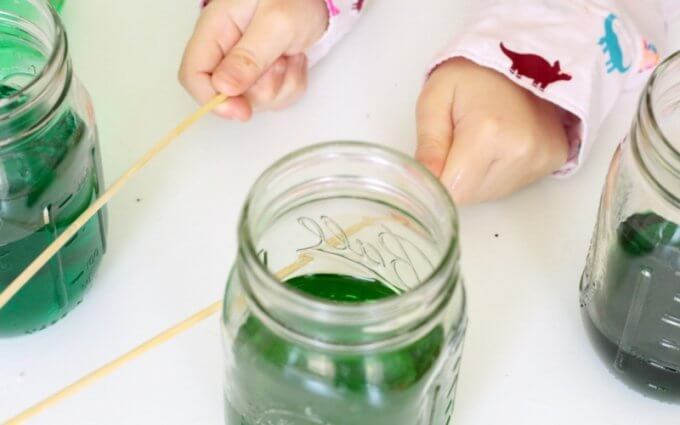
Printable Science Projects For Kids
If you’re looking to grab all of our printable science projects in one convenient place plus exclusive worksheets and bonuses like a STEAM Project pack, our Science Project Pack is what you need! Over 300+ Pages!
- 90+ classic science activities with journal pages, supply lists, set up and process, and science information. NEW! Activity-specific observation pages!
- Best science practices posters and our original science method process folders for extra alternatives!
- Be a Collector activities pack introduces kids to the world of making collections through the eyes of a scientist. What will they collect first?
- Know the Words Science vocabulary pack includes flashcards, crosswords, and word searches that illuminate keywords in the experiments!
- My science journal writing prompts explore what it means to be a scientist!!
- Bonus STEAM Project Pack: Art meets science with doable projects!
- Bonus Quick Grab Packs for Biology, Earth Science, Chemistry, and Physics

- Pingback: St Patricks Day STEM and Science Activities for Kids
- Pingback: 40 Simple Water Science Experiments for Kids - Look! We're Learning!
- Pingback: Simple Physics Activities Science Experiments STEM Ideas for Kids
- Pingback: 17 enkla experiment med vatten – Bättre hälsa
- Pingback: Reece Activity: Water Xylophone -
Comments are closed.

Subscribe to receive a free 5-Day STEM Challenge Guide
~ projects to try now ~.
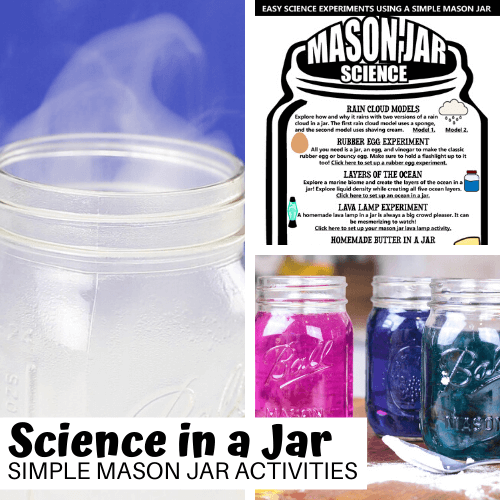

Sound Experiment for Kids to See Sound
I love science! There are so many hands-on science experiments you can do with kids! Right now we are learning all about sound in our classroom. I have personally found that having a sound experiment for kids to demonstrate what they are learning is the best way for children to really understand the material.
So, I came up with a few sound experiments for kids, including my favourite tuning fork sound experiment and vibrating rice.
Keep reading for a few simple, hands-on ways to making learning about sound fun and meaningful.
The experiments work well in the classroom or at home.
Introducing big, but important concepts, such as sound and hearing, to young children may seem early; however, I am always amazed by how much children of all ages learn from hands-on science experiments.
When children are interested in a topic, they absorb and understand a lot of the material.
Slinky Sound Experiments
Kids are naturally drawn to do experiments and play and explore with their hands. I like to do this sound experiment with kids as a way to introduce big science concepts to young minds.
I have done this experiment with kids aged 3-10 and it is a hit with all of them. All you need is a slinky. A large one works best, but any size will work.
Sound Experiments Steps
I started by using a large slinky and having one child and I hold the ends on opposite sides of the carpet. I banged the slinky to send a wave to the other side. We talked about how sound travels in waves.
A big, fast wave equals a loud sound – like someone yelling. A small, slow sound wave may be someone humming. I either hummed or yelled as I banged the slinky to replicate how the volume and sound travels.
Sound Waves
Sound Experiment
The main idea you want to make clear is that sound travels in waves. Also, it is important that children know that sound waves are invisible.
The slinky is just a fun way to show what we can’t otherwise see.
Some students even noticed the slinky bounce back after reaching the student holding the other end of the slinky. This was a great chance to discuss echoes and how sound bounces.
Fork a Sound Experiments
This is perhaps my favorite sound experiment for kids! I love the excitement that it causes and the ‘explosive’ result. Also, kids of all ages are able to get hands-on and do the experiment. You only need a few materials:
- Plastic Wrap
- Uncooked rice or Large Sparkles (I added some food coloring to mine, but the color is just for fun.)
- Tuning Forks
Since I did this experiment with several groups, I had several containers ready to go. I grouped Children into groups. The smaller the groups the better.
Cover each container tightly with plastic wrap. The wrap has to be tight or the experiment will not work.
To start, I introduced the children to tuning forks. Many had not used or seen one before. Some recognized the fork being used in their music class before.
I gently banged one of the forks onto the carpet and held it up. We could hear a bit of a sound coming from the fork.
I had a child beside me gently touch the fork. They were able to feel that it was vibrating, but as soon as they touched the tuning fork the vibrations stopped.
We talked about the fact that when it was vibrating, it was making a sound. When it stopped vibrating, the sound also stopped.
Children then each had a chance to gently try out the tuning forks. They loved the hands-on experience. (I would suggest making sure to tell children not to hit the tuning forks too hard. Just a bit of a bump will work. Also make sure they are not banging it on anything that could break.)
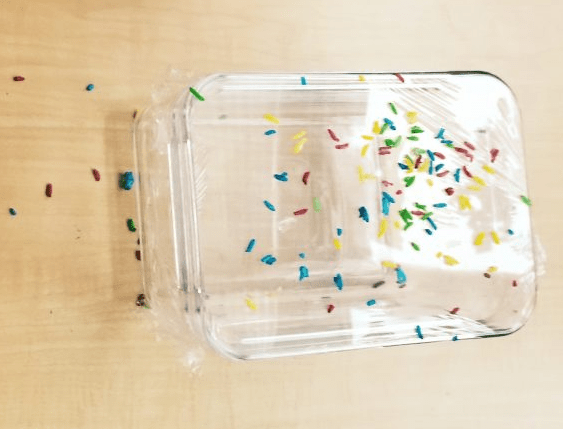
Next, children went to the tables with a small group. Each group got a container with the plastic wrap stretched across it. I then gave each group a small container of rice. You only need a small amount for each group.
Also, the more rice you give each group the more clean up there will be. The rice will go flying!!! (But that’s also the fun of the experiment.)
Children then pour the rice onto the plastic wrap. They make a guess what will happen once they touch the tuning fork to the plastic wrap.
Once they have guessed, they are ready to do the experiment.
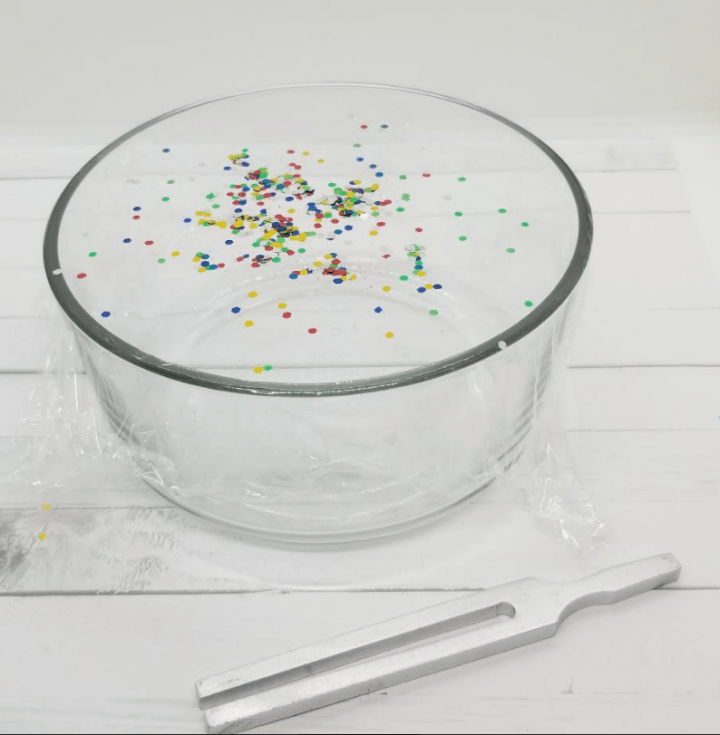
When banged, the tuning fork vibrates, which creates a sound. Tap the fork so that it is making a sound, and vibrating.
Next, touch the vibrating fork to the plastic wrap, but be sure not to touch the side of the bowl. You only need to touch it gently to get the result.
As soon as the vibrating fork touches the plastic wrap, it sends vibrations across the wrap and to where the rice is sitting. These vibrations cause the rice to “jump” until the vibrations/sound stops.
The tuning forks are ideal to have on hand when teaching or learning about sound.
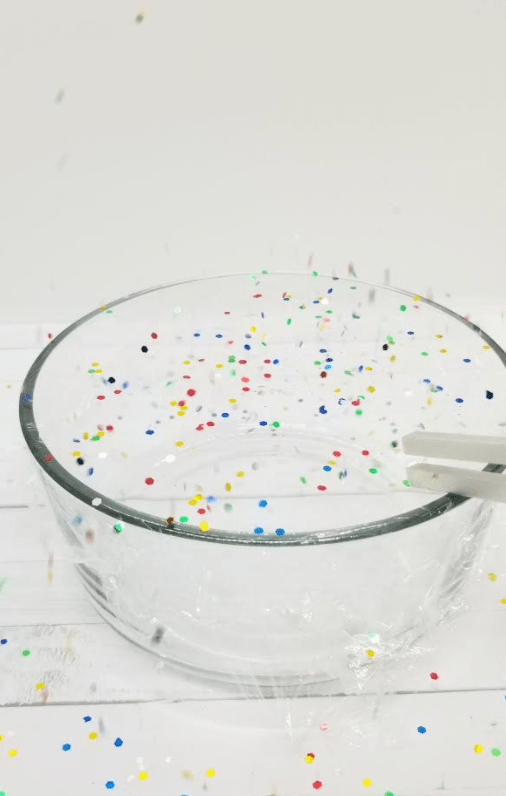
There was so much excitement in the room when the rice started bouncing everywhere! The mess is definitely worth the learning that occurred! Since the materials you need are so simple, you can repeat this tuning fork experiment several times.
I really wanted each child to be able to do the hands-on experiment. After each child got the rice to jump, the group worked together to gather the rice and put it back on the plastic wrap for the next child’s turn.
Repeat as many time as you wish!
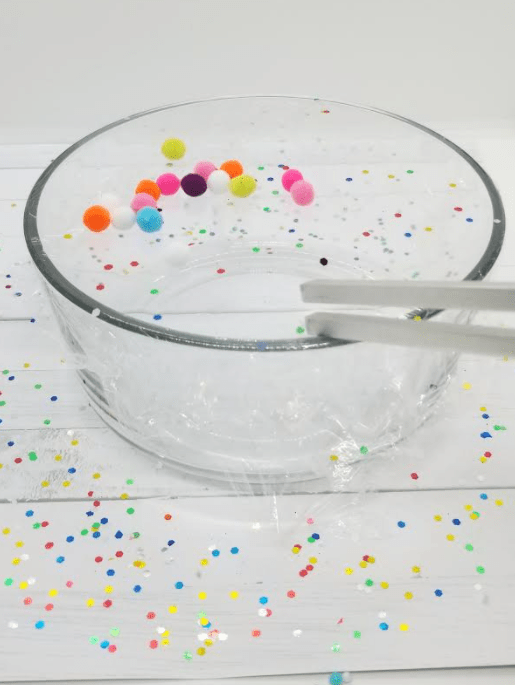
Sound Experiments Extension Activity
The tuning fork experiment sparked so much interest in my classroom that I wanted to extend our activity for another science lesson. If you have all of the materials for the fork a sound experiment, all you need extra to do another experiment is water!
As an extension, you can remove the plastic wrap and fill the glass bowls with water. I also added a few drops of food coloring just for fun.
Repeat the experiment above by banging the tuning fork and then touch it to the container with water. Make sure to only touch the water, and not the container.
When the fork is touched to the water it makes the water splash out of the bowl. This sound experiment is an easy way to show kids that sound causes vibrations/movement. Happy experimenting!
For your convenience, this post contains affiliate links. As an Amazon Associate I earn from qualifying purchases and I may earn a small commission at no cost to you.

Christmas Puzzles for Adults 1000 Pieces Winter Train Town Jigsaw Puzzles for Adult Puzzles 1000 Pieces with Letter…

Jigsaw Puzzles for Adults 1000 Pieces- Christmas Winter Snowman Frosty Friends, Jigsaw Puzzles 1000 Pieces Interloc…

Hulameda Paint Tray Palettes, Plastic Paint Pallets for Kids or Students to Paints on School Project or Art Class-1…
Join hands-on teaching ideas.
Join Hands-On Teaching Ideas to gain access to my Free Resource Library filled with lots of printable learning resources, from a choice board full of STEM activities for kids to escape room games, you can download anything that interests you for your classroom or home.
Click “Subscribe Today” button below to subscribe and download the STEAM choice board right away.

More Hands-On Teaching Ideas
If you enjoyed the sound experiments above, you may like the activities below. From science to art and even escape rooms, I’ve got lots of learning activities to keep children busy.
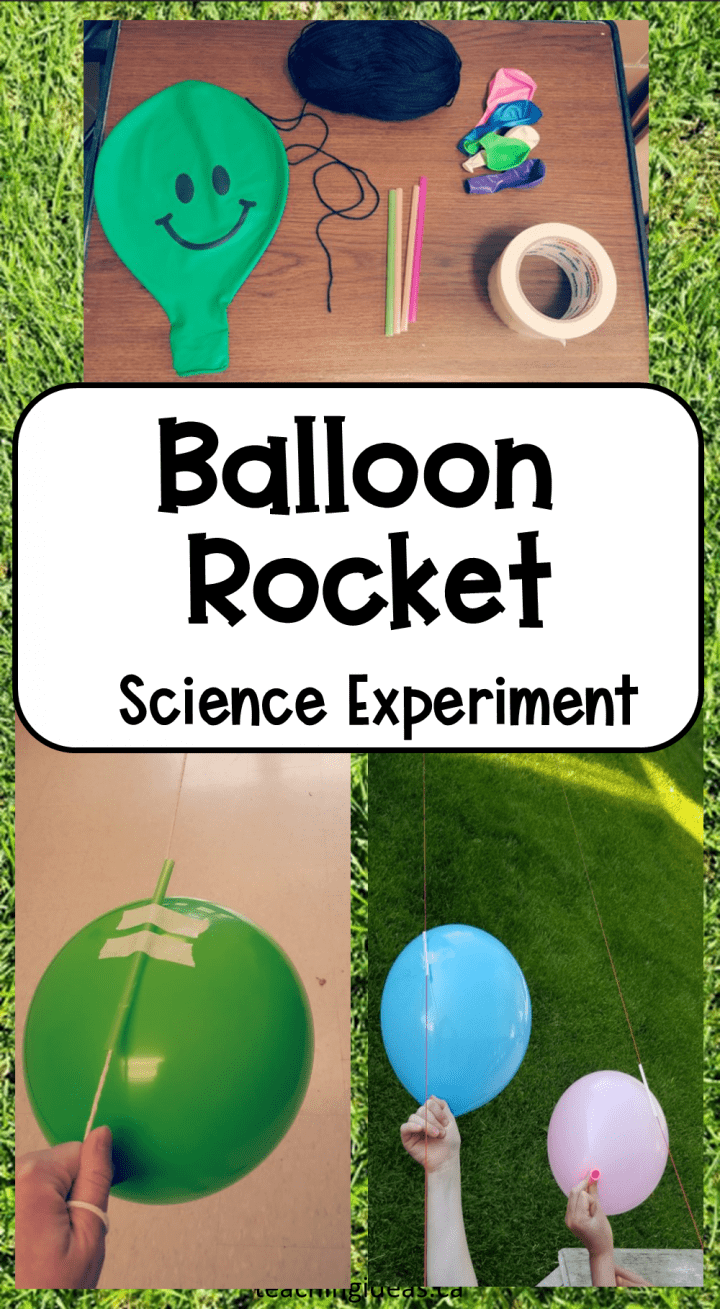
Leave a Reply Cancel Reply
Your email address will not be published.
Cool Science Experiments Headquarters
Making Science Fun, Easy to Teach and Exciting to Learn!
Science Experiments
How to See Sound Science Experiment
What does sound look like? This fun 5-item science experiment helps kids “see” sound waves and have fun while doing it.
In this article, we include a demonstration video, a supplies list, detailed printable instructions, experiment variations, and an easy to understand scientific explanation of how it works.
Bonus: Kids love this experiment because not only are they allowed to make loud drumming noises, it’s required!
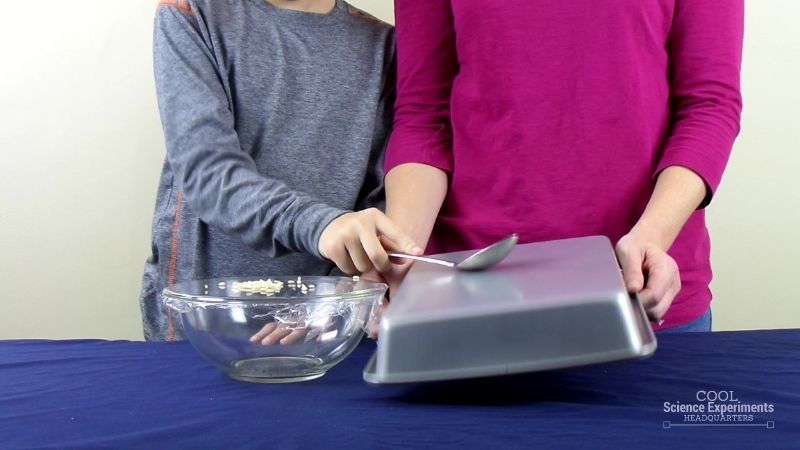
JUMP TO SECTION: Instructions | Video Tutorial | How it Works
Supplies Needed
- Plastic Wrap
- 1 teaspoon Uncooked Rice
- Metal Pan (Cookie Sheets or Pans are good options, but they must be metal)
- Metal Spoon
How to See Sound Lab Kit – Only $5
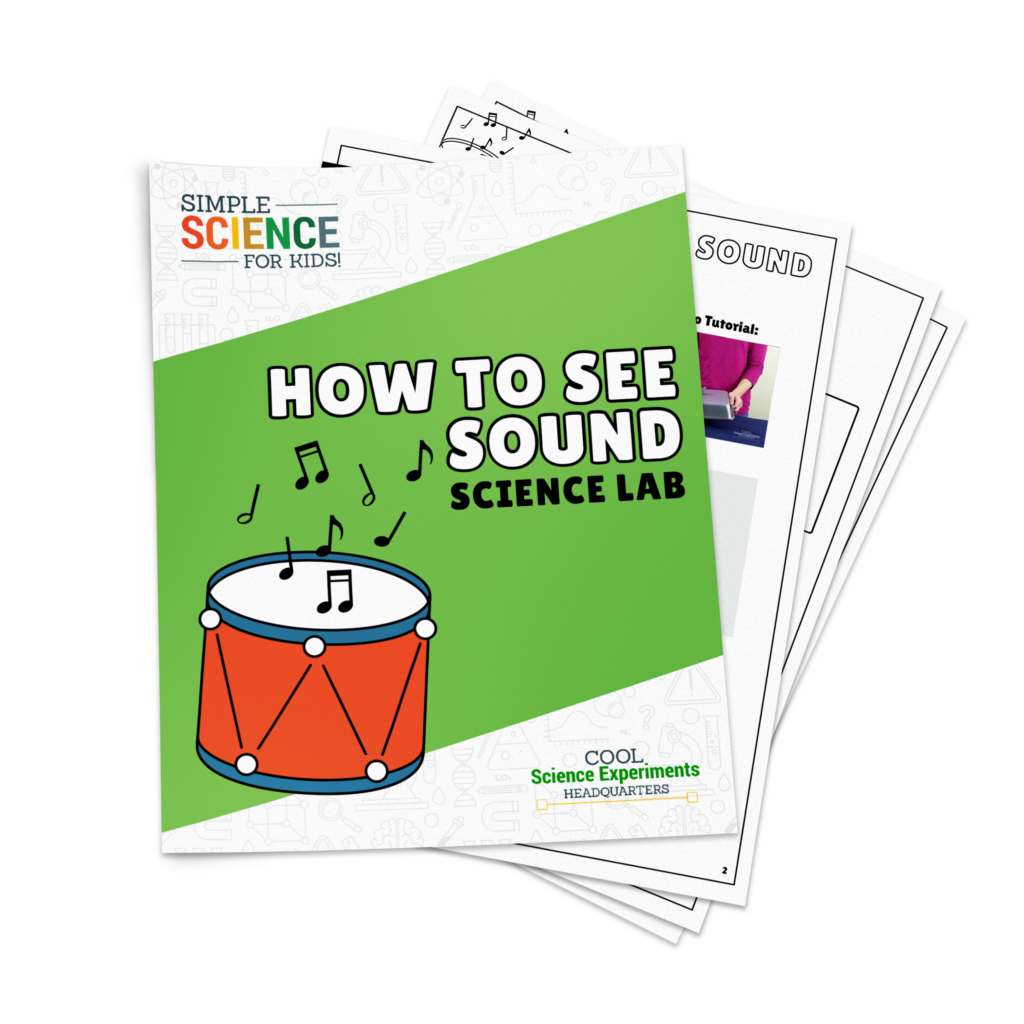
Use our easy How to See Sound Science Lab Kit to grab your students’ attention without the stress of planning!
It’s everything you need to make science easy for teachers and fun for students — using inexpensive materials you probably already have in your storage closet!
How to See Sound Science Experiment Instructions

Step 1 – Tear off a piece of plastic wrap big enough to cover the top of the bowl.
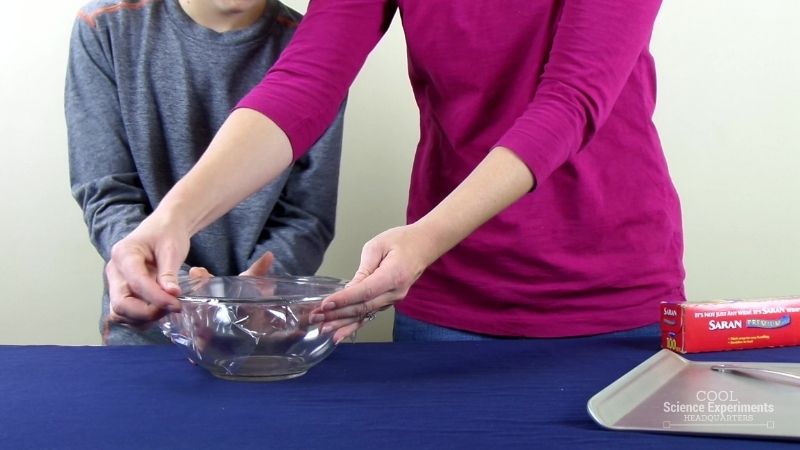
Step 2 – Secure the plastic wrap over the bowl. Make sure that the plastic wrap is very tight.

Step 3 – Pour 1 teaspoon of uncooked rice on the top of the plastic wrap.

Step 4 – Hold the metal pan in the air and position it next to the bowl. What do you think will happen if you hit the pan with the spoon?
Helpful Tip: Remember, the pan must be metal or the experiment won’t work.
Step 5 – Take the metal spoon and bang on the metal pan like a drum and watch what happens to the rice. Write down your observations. Do you know the why the rice moved? Find out the answer in the how does this experiment work section below.
Video Tutorial
How to See Sound Science Experiment Step by Step Instructional Video
How Does the Experiment Work?
Sound is a disturbance that travels through a medium as a wave. In this experiment, when you hit the metal pan with the spoon, you disturb the particles of the pan causing them to vibrate. The vibrations in the pan are transferred to the air surrounding the pan, creating a sound wave.
When these sound waves reach the plastic wrap it disturbs the particles of the plastic wrap causing them to vibrate. These vibrations in the plastic wrap cause the rice to move. Sound waves traveling through the air are also what allow us to hear the noise of the spoon hitting the pan.
Other Ideas to Try
Try this experiment again, but change the distance of the pan from the bowl. As you move the pan farther away from the bowl, do the sound waves have the same effect on the rice grains?
I hope you enjoyed the experiment. Here are some printable instructions:
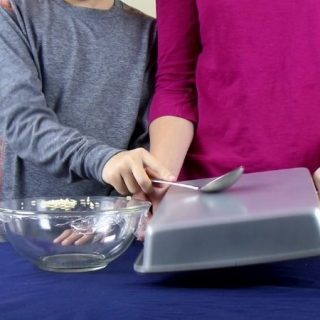
Instructions
- Tear off a piece of plastic wrap big enough to cover the top of the bowl.
- Secure the plastic wrap over the bowl. Make sure that the plastic wrap is very tight.
- Pour 1 teaspoon of uncooked rice on the top of the plastic wrap.
- Hold the metal pan in the air and position it next to the bowl
- Take the metal spoon and bang on the metal pan like a drum and watch what happens to the rice.
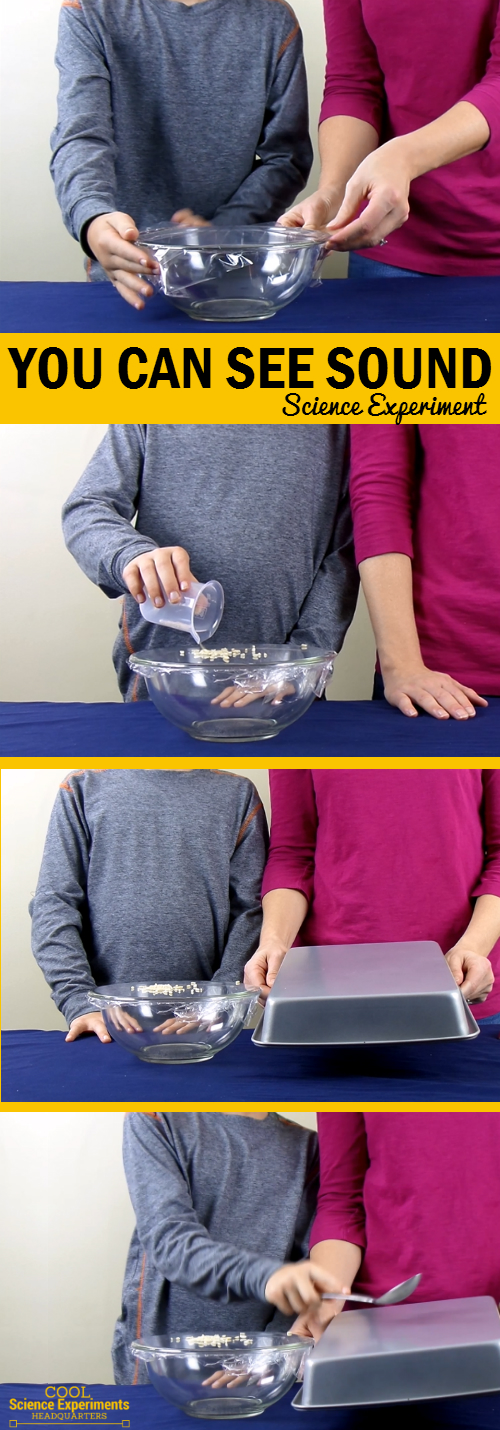
Reader Interactions
September 27, 2016 at 2:29 pm
I am trying to see the answer for the “Why can’t we see sound?” but I xan’t find it here. Can you help me, please?
February 2, 2017 at 11:37 pm
Invisible sound waves
May 21, 2019 at 9:57 pm
Sound is a vibration
March 12, 2017 at 10:15 pm
Because when you hit the tin it makes a hard and loud noise.
December 7, 2017 at 2:44 pm
This was an amazing experiment ever
January 31, 2018 at 5:08 pm
It is because the rice is having potential energy while it is on the wrap. Than and only then when you hit the pan is when it turns to kinetic energy.
October 31, 2018 at 8:56 pm
The sound waves bounce off the pan and travel to the drum. The drum vibrates and the rice jumps.
January 26, 2019 at 5:32 pm
Why can’t I get this to work
does the type of plastic wrap matter?
March 9, 2020 at 8:21 pm
it doesn’t work for me too 🙁
Leave a Reply Cancel reply
Your email address will not be published. Required fields are marked *
Save my name, email, and website in this browser for the next time I comment.

- Privacy Policy
- Disclosure Policy
Copyright © 2024 · Cool Science Experiments HQ
School • Things To Do
3 Fun and Easy Sound Experiments for Kids
May 15, 2022

Like this? Share it with your network!
How do you explain ‘sound’? Why do we have two ears? Can you hear in space? Dr Naomi Lavelle from Dr How’s Science Wows explains and explores the science of sound with 3 fun and easy sound experiments for kids to try.
Science is all around us, from the air we breathe to everything we can see, smell, touch, taste and hear around us. Encouraging a love of science can start at a young age, and you can do plenty of easy science experiments at home using normal household items.
With these three simple sound experiments, your child can learn all about sound – perhaps something we don’t really think about too much?
YOU MAY ALSO ENJOY: Download Your FREE Fun Sound Scavenger Hunt for Kids
What is Sound?
Sound is a type of energy made by vibrations. These sound vibrations move through the air (or other matter) to our ear and our brain can then work out what we are hearing.
Sound vibrations travel as a type of wave that we cannot see. These sound waves need something containing molecules (particles) to travel through. Sound waves can travel through solids, liquids and gases (air), because they are made up of molecules. The molecules carry sound waves by bumping into each other, just like dominoes knocking each other over.
Did you know? Sound waves travel in water at a speed of nearly one mile (1.6 km) a second, which is more than four times faster than sound travels through air!
Why Do We Need Two Ears?

We need two ears to work out exactly where a noise is coming from. Our brain can compare the level of noise reaching each ear and calculate the position of the source of the noise.
Did you know? During the making of the film Jurassic Park , Stephen Spielberg wanted a dramatic effect to signal the arrival of the T. rex.
Inspiration finally came while he was driving home listening to Earth, Wind and Fire and noticed the vibration effect of the base rhythm.
In the film we see ripples in a glass of water, caused by the T. rex‛s footsteps. This special effect was achieved by someone plucking guitar strings under the dashboard.
You Have Mail!
Get our best content direct to your inbox! You’ll receive quick and easy recipes, fun ideas to entertain the kids, parenting tips, great competitions, as well as offers from brands we trust.
Can We Hear in Space?
Sound waves need molecules to travel through so, as there are no molecules in space (or very little), there is no sound in space.
Did you know? Thunder is the sound made by lightning? Sound travels in air at a speed of about one mile in five seconds.
If you count the seconds between seeing the lightning and hearing the thunder you can work out the distance from the source of the thunder.
For example, if you count ten seconds between the lightning and the thunder then you can tell the storm is about two miles away.
What is Echolocation?

An echo is made when sound waves you make bounce off a solid object and travel back to your ear. Some mammals use echoes to help to navigate and to find food – this is called echolocation.
Bats use echolocation to fly and hunt at night. They send out high pitched squeaks and clicks almost constantly. These sounds are called ultrasonic, they are too high for humans to hear. A bat can tell from the echoes bouncing back to it, where an object is, its size and shape and whether it is moving or not.
Whales and dolphins use echolocation just like bats, but the ultrasonic sounds they make travel through water instead of air.
Did you know? A bat can detect an object as small as a human hair using echolocation!
YOU MAY ALSO ENJOY: How to Make an Easy Homemade Lava Lamp
Download our 50 fun outdoor activities checklist for lots of great ideas to enjoy in the fresh air!

3 Fun Sound Experiments to Try at Home
#1. can you feel sound waves.
You Will Need:
What to Do: Blow up the balloon and tie it closed. Turn on the radio to a song with low base music. Hold the balloon between your two hands and hold it very near the speaker of the radio. What can you feel? Change to a different radio station and see if the vibrations change.
What is Happening? The sound coming from the radio makes the air near it vibrate. The air molecules in the balloon are squeezed more tightly together making them vibrate more strongly. We feel these vibrations in our hands.
#2. Can You Make Sound with Bottles?
- two identical bottles
What to Do: Fill one of the bottles two-thirds full with water and the other bottle one-third full. First, blow across the top of each of the bottles – which one makes a higher sound? Next, tap each of the bottles with the spoon – now which one makes the higher sound?
What is Happening? Blowing across the top of the bottles makes the air inside vibrate. The bottle with less air will make the higher sound. When you tap the bottles it is the water that vibrates. The bottle with less water will make the higher sound. Small amounts of air or water vibrate more quickly, making a higher sound.
Next Step: If you want to make this even more fun, you can use a lot of bottles with different amounts of water in each and see how many different sounds you can get!
#3. Can You Watch Sound Waves Travel?
- a small plastic drinking bottle (empty)
- a small piece of plastic (i.e. a plastic bag)
- an elastic band
- a tea-light candle
What to Do: Use the scissors to carefully cut the end off the plastic bottle (ask an adult to do it for you). Stretch the piece of plastic over the open end of the bottle and secure it using the elastic band. Ask an adult to light the tea-light for you, and remove the bottle cap. Hold the narrow end of the bottle near the flame and then tap on the plastic at the other end of the bottle. What happens to the flame?
What is Happening? When you tap the plastic it acts like a drum. The sound waves it creates make the air molecules vibrate. These vibrating molecules then make the molecules beside them vibrate. The vibrations travel through the air in the bottle and blow out the flame.
You can see these sound experiments demonstrated here:
Visit Science Wows for more fun science facts and experiments and follow Dr How on Facebook and Twitter .
YOU MAY ALSO ENJOY: 18 Easy Science Experiments Perfect for Preschoolers

About the Author: Jill Holtz
Related Posts

What’s On October 2024!

What’s On September 2024!

What’s On August 2024!

Here Are the School Holidays 2024-2025
You may also enjoy.

SenShin Sports Exciting New Venture

The Most Wonderful Places to Visit Santa and Stay Over in Ireland

Not-So-Spooky Things to Do in Ireland This Halloween Midterm

10 MORE Incredibly Easy Pumpkin Recipes to Make at Home

15 Fantastic Family Events for Culture Night 2024
You’ve got mail.
Get our best content direct to your inbox! You’ll receive quick and easy recipes, fun ideas to entertain the kids, parenting tips, competitions, as well as offers from brands we trust.
Things to Do
Entertainment.
© 2021 • Mykidstime • All Rights Reserved • Privacy Policy • Terms of Use
Andrea Knight
Teacher · Learner · Author
Sound Experiments

This science unit is so fun. It’s loaded with my favorite sound experiments, like this one. I first saw this idea in a library book and, to be honest, I didn’t expect it to be that big of a deal (or even work, if I’m still being honest). But to my surprise, it actually delivered. I think I suffer from Pinterest-Fail PTSD.
Singing Spoons is a fun way to show kids how volume and pitch change depending on whether sound waves are traveling through the air or through a solid, similar to the way a stethoscope works. It’s one of our favorite sound experiments and is pretty easy to set up. Just use tape to connect three metal spoons to a piece of string or yarn. Then, jiggle the string so the spoons swing into one another and observe the sound they make. It should sound dull and tinny. Next, wrap the ends of the string around your fingers as if you were going to floss your teeth. Place only the yarn-wrapped fingers in your ears (again, think of a stethoscope) and swing the spoons again. Notice how the pitch and volume change.
Even the adults in my house thought this was cool. And one of them is fairly hard to impress.😉

This experiment can easily be done without these sheets👇, but I like reading procedural and informational texts with my students and I also like having a place for them to record their own ideas during investigations.

More Sound Experiments
Hands down, the most satisfying part of planning this science unit was finally engineering a harmonica that actually works! I’m not exaggerating when I tell you how much we were geeking out over this one… maybe because it was our third attempt. But I guess that’s the nature of science experiments, right? In the one pictured below, changing the distance between the pink straws changes the pitch of the sound. Shorten the gap and the pitch will rise. Spread them back out and the sound will become lower. It’s all about vibrations and sound waves .
And the bee?🐝 If you swing it like a lasso above your head, it really does buzz! It’s another fun way to teach your students that vibrations cause sound.

I created student recording sheets for these sound experiments, as well as procedural posters (with picture support) and kid-friendly explanation sheets. These explanations help young children understand the science they’re observing, but I also like how they give families an age-appropriate context to build from when they want to talk to their kids about science.

Making a sound wave model takes some time, but the wow factor can’t be denied! You only need three things to make your model: duct tape, wooden skewers, and clay. NOTE: To save time, we built ours using jellybeans, but I think the weight of the clay would provide an even better result. If you use clay, roll each ball to roughly the size of a large grape.

Nonfiction Science Text
I have a hard time finding science material my first-graders can actually read, so it has become my habit to just write our own. It’s a win-win really because then I have a paper copy for each of them. By having their own, we can not only read it together, but the kids can practice it independently and even take it home to share with their families. The books serve double-duty during reading and phonics instruction, too. We can highlight key vocabulary words, find and circle word wall words, and even personalize the interactive pages.
This science book, What Is Sound? , introduces children to the concept of sound and how it behaves. Key science vocabulary such as pitch , volume , vibrate , and echo are emphasized in the text.

Key Vocabulary Posters
There are some pretty BIG words for some pretty young kids in this science unit, so I created a set of posters to help the children understand and remember them. Each poster features the key science term, a colorful graphic, and a kid-friendly definition. The set includes 8 different posters for the following vocabulary words:
- communicate

Key Word Game Cards
Mini-versions of the key word posters have been included in the resource. Originally, I just intended to use them as cards in a “Memory” style game, but they’re also good for student-pairing activities and vocabulary review. There are nine pairs of words in the set: sound, waves, vibrate, volume, pitch, echo, ear, communicate, and loud .

Student Worksheets
I also included some additional worksheets to help support science instruction and provide a connection to other subject areas, such as writing and phonics.
You can preview more of this first grade science unit👉 HERE . It includes printable materials for teaching children the science behind light and sound, as well as how we use both to communicate with others.
Science Ideas on Pinterest
Even though I teased about a Pinterest-Fail at the beginning of this post, I do love Pinterest. (I have discovered though, if it looks too good to be true, it probably is.😂) If you’re planning a science unit on the study of light and sound, click over to my Pinterest board: Light and Sound Science . I’ve added pins that lead to great ideas for supporting your instruction. You’ll find science videos, book suggestions, integrated projects, and more.

Recommended Book List
Check your school or local library for titles to support your science instruction. These are some of the books I’ve used for read-alouds and to help build my own background knowledge as I planned the unit.
- Sounds All Around by Wendy Pfeffer
- How Sound Moves by Sharon Coan
- How Does Sound Change? by Robin Johnson
- Oscar and the Bat by Geoff Waring
- The Listening Walk by Paul Showers
- Sending Messages with Light and Sound by Jennifer Boothroyd
CLICK👇TO PREVIEW THE RESOURCE

LIGHT AND SOUND SCIENCE UNIT
Happy teaching!
MORE SCIENCE POSTS FOR 1ST GRADE

In the Loop

IMAGES
VIDEO
COMMENTS
18. Blocking Noise. In the Block That Noise! project, students learn about the ways in which sound waves are reflected, absorbed, or transmitted by different materials. In the lesson, students use what they learn about absorbing sound to build sound-insulating containers big enough to hold a phone.
6. Musical Wine Glasses. The musical wine glass experiment is a fun and easy way to explore the science of sound and create your own musical instrument. By filling wine glasses with different amounts of water and tapping them with a spoon, you can produce a range of musical notes and create your own melodies. 7. Tuning Fork Resonance Experiment.
Sound Wave Experiment #2 The Ringing Fork on a String. For this simple sound wave experiment you just need a fork or a spoon tied onto a piece of yarn. Make sure the yarn is long enough to hang down from your ears to around your chest or stomach. Tie the fork right in the center of the piece of yarn or string.
Cut a hole on the top of the box, about 8-10 inches in diameter. This is the sound hole for our instrument. On the top of the box, poke a smaller hole or cut an "x" just large enough to fit the broomstick through. Slide the broomstick through the hole and let it rest on the bottom of the box.
This article shares 7 cool sound science experiments your child will love! Toggle navigation Go Ad-Free Worksheets. Grades. Preschool Kindergarten Grade 1 Grade 2 Grade 3. ... Making musical instruments are easy and fun, and they teach kids about sound waves and pitch. This experiment is much like the pan flute above, but kids can alter the ...
Sound Science Experiments: Bug On A Leash Make A Crazy Kazoo Duck In A Cup Super Easy Pan Flute WATCH FOUR FUN SOUND SCIENCE EXPERIMENTS ANYONE CAN DO Description: Bug On A Leash - Make a fun bug wing simulator that makes a really cool sound. Make A Crazy Kazoo - This kazoo is super easy and sounds awesome. Duck In A Cup - The silly noise made by this contraption will "quack" you up its so ...
Put the plastic wrap tightly over the bowl. (One sheet, as tight as you can get it.) Put about 1 teaspoon of rice on the plastic. Then hold the metal pan close to the bowl and have your child hit it with the spoon. The harder they hit it the better. The rice will dance!
In this fun and easy sound science experiment, we're going to explore and investigate sound by making noisy paper. This is a great sound science activity that easily helps visualize the relationship between mechanical vibrations and the resulting sound. You will easily be able to watch the paper vibrate and hear the sound the noisy paper makes. Materials: Two pieces of printer paper ...
One of the coolest sound wave experiments your kids will ever try! We love doing simple science experiments and every once in a while, we find a GEM. It's a simple, easy and pretty awesome experiment that explores the science of sound waves and how they travel .
STEP 1. Fill the jars with varying levels of water. You can eyeball the amounts or grab the measuring cups and get a little more scientific with your exploration. STEP 2. Add food coloring to make different colors for each note. More water equals lower sound or pitch and less water equals a higher sound or pitch.
The sound should have been louder. Ask your student why the second sound was louder. Pulling the string or rubber band back farther created a larger vibration, thus a louder sound. The volume increased. To make a softer sound, don't pull the string or rubber band back as far. Repeat the experiment and look closely.
Explore the science of sound with these 4 experiments, then use your knowledge to make your own DIY instrument! Read about the science behind these here: htt...
Repeat the experiment above by banging the tuning fork and then touch it to the container with water. Make sure to only touch the water, and not the container. When the fork is touched to the water it makes the water splash out of the bowl. This sound experiment is an easy way to show kids that sound causes vibrations/movement. Happy experimenting!
Step 1 - Tear off a piece of plastic wrap big enough to cover the top of the bowl. Step 2 - Secure the plastic wrap over the bowl. Make sure that the plastic wrap is very tight. Step 3 - Pour 1 teaspoon of uncooked rice on the top of the plastic wrap. Step 4 - Hold the metal pan in the air and position it next to the bowl.
The bottle with less water will make the higher sound. Small amounts of air or water vibrate more quickly, making a higher sound. Next Step: If you want to make this even more fun, you can use a lot of bottles with different amounts of water in each and see how many different sounds you can get! #3.
To learn more about how Acoustical Solutions can solve your noise control problems, use our contact form, call one of our Acoustical Sales Consultants at (800) 782-5742, or visit us on the web at acousticalsolutions.com. Here are some fun sound experiments parents and teachers can use to get their youngster's brains working hard again - and ...
Here is a compilation of four of our favorite sound science experiments that anyone can do. These experiments and activities are simple to perform, inexpensi...
1. Exploring Sound Waves with Spoons. This is a simple sound science experiment for kids. All you need is a couple of spoons, some string and our clear instructions. Exploring Sound Waves with Spoons Experiment. 2. Make a String Telephone Craft Instructions. This is an absolute classic.
Singing Spoons is a fun way to show kids how volume and pitch change depending on whether sound waves are traveling through the air or through a solid, similar to the way a stethoscope works. It's one of our favorite sound experiments and is pretty easy to set up. Just use tape to connect three metal spoons to a piece of string or yarn.
Cut 2 1-inch pieces off of the straw. Stretch your wide rubber band length-wise around a large popsicle stick. Place a straw piece under the rubber band, close to the edge on one end. Place a second popsicle stick directly on top of the one that's already rubber banded. Secure the sticks together at each end using the small rubber bands.